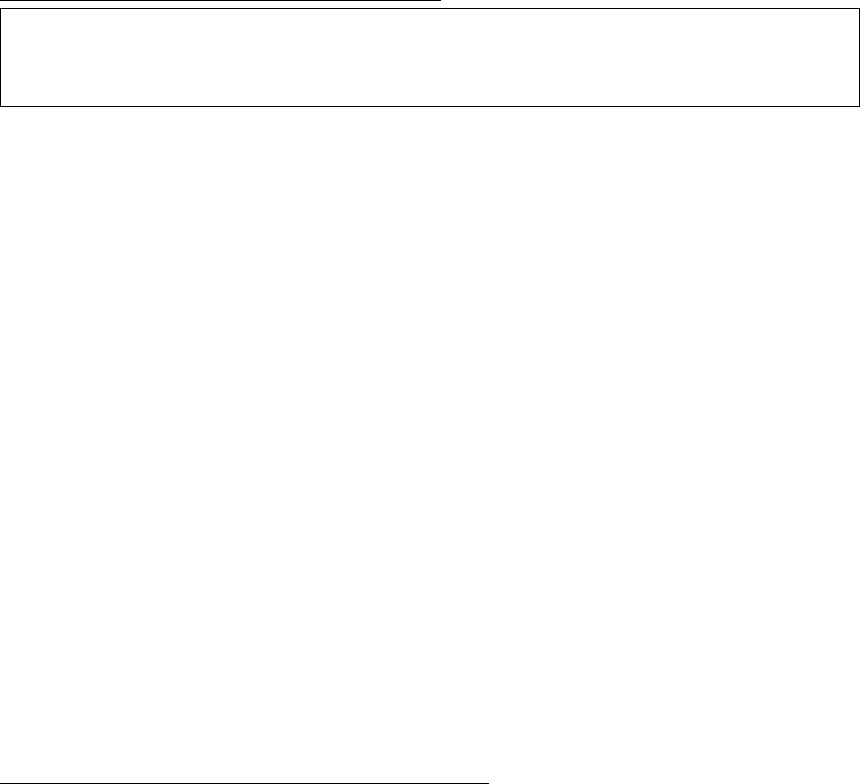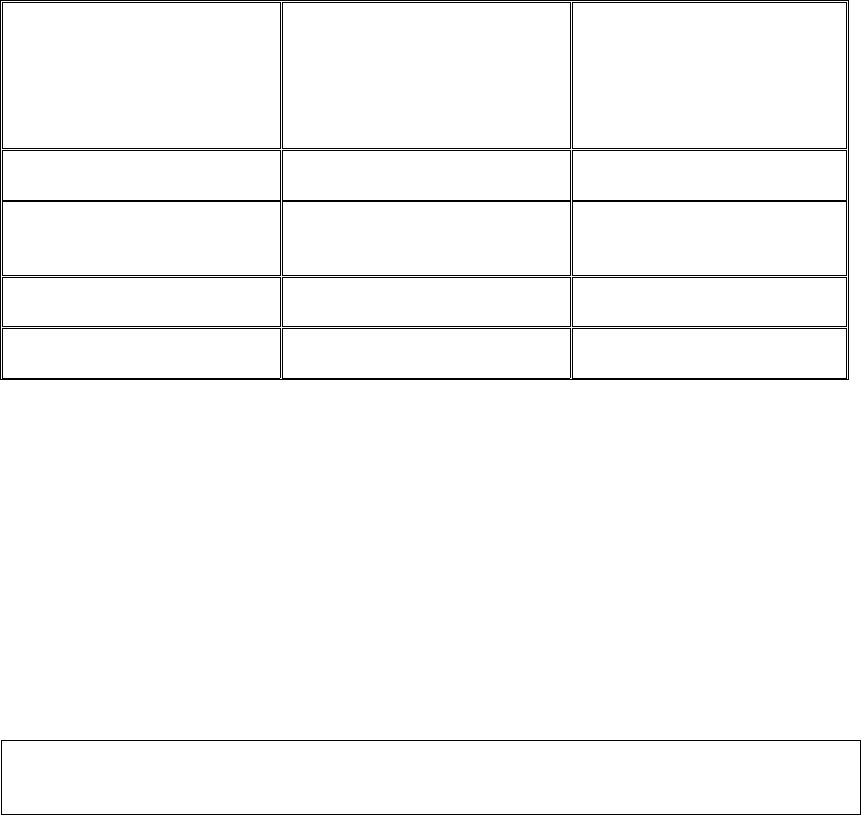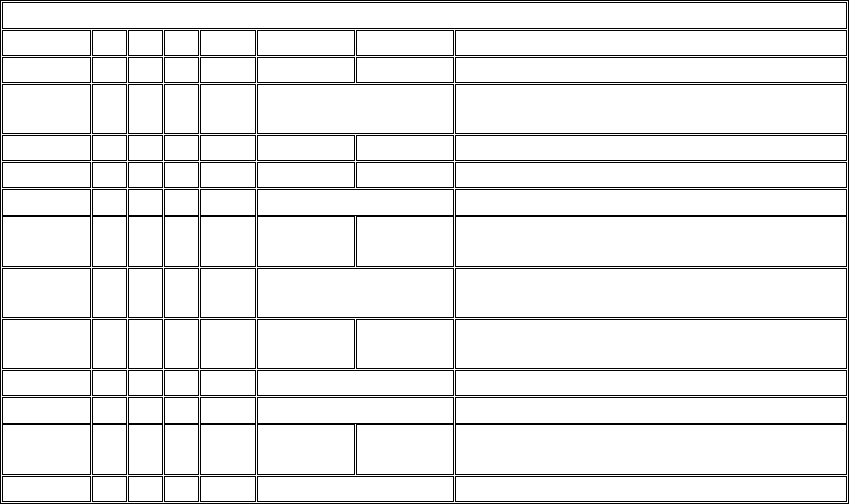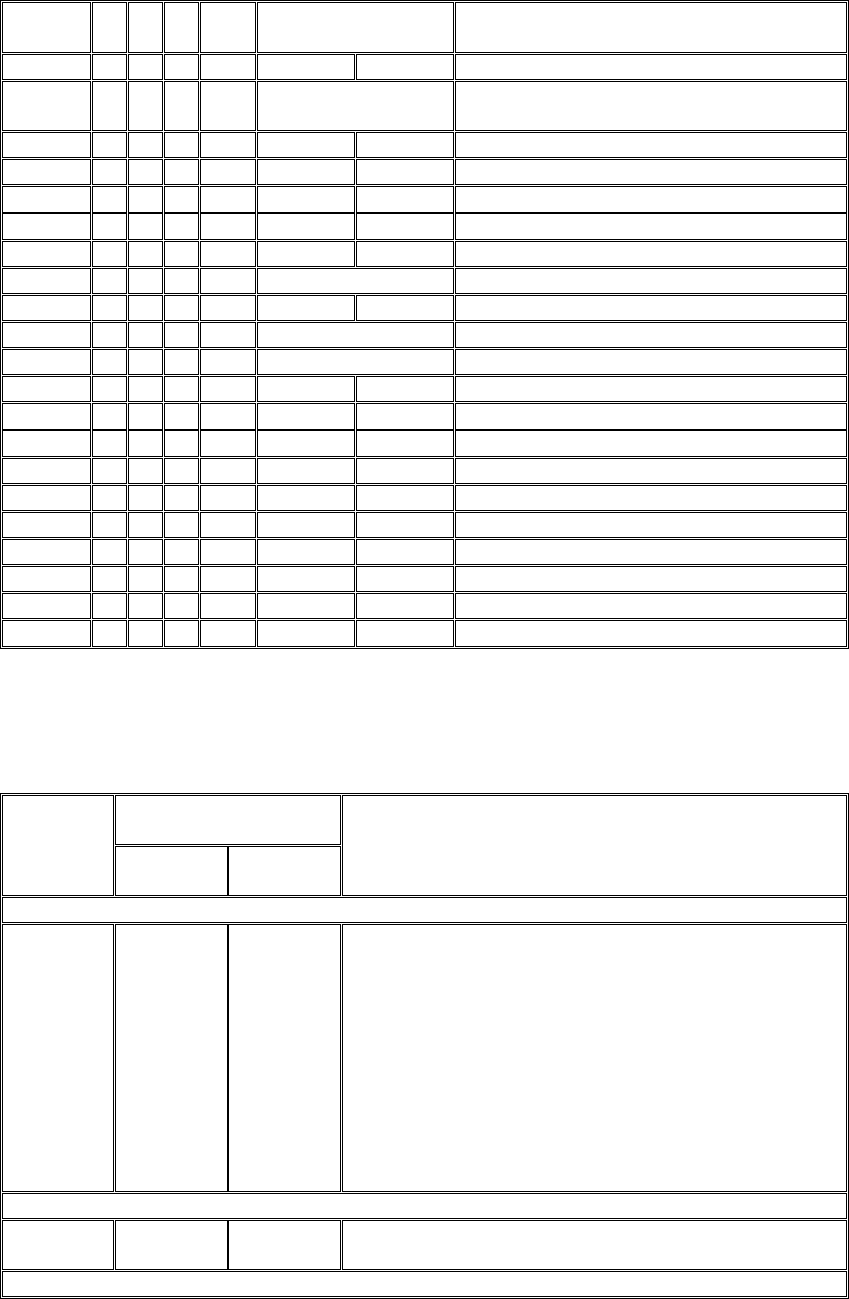Yaesu Musen 30313X30 HANDHELD VHF TRANSCEIVER User Manual HX850 Operating Manual
Yaesu Musen Co., Ltd. HANDHELD VHF TRANSCEIVER HX850 Operating Manual
USERS MANUAL

FCC ID:K6630313X30
IC ID:511B-30313X30
Operating Manual
Vertex Standard Co.,Ltd. 1
Operating Manual
Congratulations on your purchase of the HX850S! Whether this is your first portable marine VHF
transceiver, or if you have other STANDARD HORIZON equipment, the STANDARD HORIZON
organization is committed to ensuring your enjoyment of this high performance transceiver, which
should provide you with many years of satisfying communications even in the harshest of
environments. STANDARD HORIZON technical support personnel stands behind every product
sold, and we invite you to contact us should you require technical advice or assistance.
We appreciate your purchase of the HX850S, and encourage you to read this manual thoroughly, so
as to learn and fully understand the capabilities of the HX850S.
WARNING
This radio is capable of transmitting on VHF Marine.
The FCC allows the use of VHF Marine band on water areas only. However the FCC does not allow
the use of the VHF Marine band when on land. If persons use the VHF Marine Band on land and
interfere with others communicating, the FCC will be notified and search for the interference.
Responsible parties found to be transmitting on the VHF Marine Band on land could be fined up to
$10,000 for the first offense.
The FCC does however prohibit the use in aircraft.
RF EXPOSURE SAFETY STATEMENT
SAFETY INFORMATION
Your wireless handheld portable transceiver contains a low power transmitter. When the
Push-to-Talk (PTT) button is pushed, the transceiver sends out radio frequency (RF) signals. In
August 1996, the Federal Communications Commission adopted RF exposure guidelines with safety
levels for hand-held wireless devices.
This device is authorized to operate at a duty factor not to exceed 50% (this corresponds to 50%
transmission time and 50% reception time).
WARNING: To maintain compliance with the FCC’s RF exposure guidelines, this transmitter and its
antenna must maintain a separation distance of at least 1 inch (2.5 centimeters) from your face.
Speak in a normal voice, with the antenna pointed up and away from the face at the required
separation distance.
If you use a headset accessory for this radio, with the radio worn on your body, use only the Vertex
Standard belt clip for this transceiver, and ensure that the antenna is at least 1 inch (2.5 centimeters)
from your body when transmitting.
Use only the supplied antenna. Unauthorized antennas, modifications, or attachments could damage
the transmitter, and may violate FCC regulations.
NOTE
This radio telephone complies with the requirements of RTCM Paper 56-95/SC101 Standards for
digital selective calling (DSC) for Marine transceivers.
FCC AND CANADA RADIO LICENSE INFORMATION
Standard Horizon radios comply with the Federal Communication Commission (FCC) and
FCC ID:K6630313X30
IC ID:511B-30313X30
Operating Manual
Vertex Standard Co.,Ltd. 2
Industry-Canada requirements that regulate the Maritime Radio Service.
MARITIME STATION LICENSE
An FCC ship station license is no longer required for any vessel traveling in U.S. waters which uses
a VHF marine radio, RADAR or EPIRB, and which is not required to carry radio equipment.
However, any vessel required to carry a marine radio on an international voyage, carrying a HF
single side band radiotelephone or marine satellite terminal. FCC license forms, including
applications for ship (506) and land station licenses can be downloaded via the Internet at
www.fcc.gov/forms. To obtain a form from the FCC, call (888) 225-5322.
MARINE RADIO CALL SIGN
Currently the FCC does not require recreational boaters to have a Ship Radio Station License. The
USCG recommends the boats registration number and the state to be used.
CANADIAN SHIP STATION LICENSING
You may need a license when traveling in Canada. If you do need a license contact their nearest field
office or regional office or write:
Industry Canada
Radio Regulatory Branch
Attn: DOSP
300 Slater Street
Ottawa, Ontario
Canada, KIA 0C8
FCC/INDUSTRY CANADA INFORMATON
The following data pertaining to the transceiver is necessary to fill out the license application.
FCC Type Accepted: Part 80
Output Power with FNB-V99LI: 1 W (Low), 2.5 W (Mid) ,5 W (High) , and 6 W (Nor)
Emission: 16K0G3E, 16K0G2B
Frequency Range: 156.025 to 163.275MHz
FCC Type Number:
Industry Canada Type Approval:
FCC NOTICE

FCC ID:K6630313X30
IC ID:511B-30313X30
Operating Manual
Vertex Standard Co.,Ltd. 3
Unauthorized changes or modifications to this equipment may void compliance with FCC Rules.
Any change or modification must be approved in writing by STANDARD HORIZON, a Marine
Division of VERTEX STANDARD.
NOTICE
This equipment has been tested and found to comply with the limits for a Class B digital device,
pursuant to Part 15 of the FCC Rules. These limits are designed to provide reasonable protection
against harmful interference in a residential installation. This equipment generates uses and can
radiate radio frequency energy and, if not installed and used in accordance with the instructions, may
cause harmful interference to radio communications. However, there is no guarantee that
interference will not occur in a particular installation. If this equipment does cause harmful
interference to radio or television reception, which can be determined by turning the equipment off
and on, the user is encouraged to try to correct the interference by one or more of the following
measures:
Increase the separation between the equipment and receiver.
Connect the equipment into an outlet on a circuit different from that to which the receiver is
connected.
Consult the dealer or an experienced marine electronics technician for help.
1. GENERAL INFORMATION
1.1 INTRODUCTION
The HX850S is a SUBMERSIBLE miniature 6-Watt portable two way marine transceiver. The
transceiver has all allocated USA, International, or Canadian channels. It has emergency channel 16
which can be immediately selected from any channel by pressing the [16/9] key. NOAA Weather
channels can also be accessed immediately by pressing the [WX] key.
The HX850S includes the following features: Memory Scanning, Priority Scanning, NOAA Weather
Alert, Battery Saver, easy-to-read large LCD display, EEPROM memory back-up, Battery Life
displayed on LCD, and a transmit Time-Out Timer (TOT).
In the marine band, the transmitter provides a maximum of 6 Watts output, and has the selection of 5
Watts, 2.5 Watts, and 1 Watt to assist the user in ensuring maximum battery life.
2. ACCESSORIES
2.1 PACKING LIST
When the package containing the transceiver is first opened, please check it for the following
contents:
HX850S Transceiver
FNB-V99LI 7.4 V, 1150 mAh LI-ion Battery Pack
CD-38 Charger Cradle for HX850S
NC-88B 120VAC Wall Charger for CD-38
E-DC-19A DC Cable with 12 V Cigarette Lighter Plug for CD-38
FCC ID:K6630313X30
IC ID:511B-30313X30
Operating Manual
Vertex Standard Co.,Ltd. 4
CLIP-19 Belt Clip
Owner’s Manual
2.2 OPTIONS
CMP460 Noise-canceling Waterproof Speaker/Microphone
MH-57A4B Mini Speaker/Microphone
VC-24 VOX Headset
FBA-38 Alkaline Battery Case
FNB-V99LI 7.4 V, 1000 mAh LI-ion Battery Pack
E-DC-19A DC Cable with 12 V Cigarette Lighter Plug
NC-88C 230-240 VAC Wall Charger for the FNB-V99LI
E-DC-6 DC Cable; plug and wire only
Note: Before operating the HX850S for the first time, it is recommended that the battery be charged.
Please see section 4.1.4 “USING THE CD-38 CHARGER CRADLE” for details.
3. ABOUT THIS RADIO
3.1 ABOUT THE VHF MARINE BAND
WARNING:
The radio frequencies used in the VHF marine band lie between 156 and 158 MHz with NOAA
Weather stations available between 161 and 163 MHz. The marine VHF band provides
communications over distances that are essentially “Line of sight” Actual transmission range
depends much more on antenna type, gain and height than on the power output of the transmitter. On
a fixed mount 25W radio transmission expected distances can be greater than 15 miles, for a portable
5W radio transmission the expected distance can be greater than 5 miles in “Line of sight.”
The user of a Marine VHF radio is subject to severe fines if the radio is used on land. The reasoning
for this is you may be near an inland waterway, or propagation anomalies may cause your
transmission to be heard in a waterway. If this occurs, depending upon the marine VHF channel on
which you are transmitting, you could interfere with a search and rescue case, or contribute to a
collision between passing ships. For VHF Marine channel assignments refer to page ?? section 11.
4. GETTING STARTED
If the radio has never been used, or its charge is depleted, it may be charged by connecting the
CD-38 Charger Cradle with the NC-88 battery charger, as shown in the illustration. If 12V DC

FCC ID:K6630313X30
IC ID:511B-30313X30
Operating Manual
Vertex Standard Co.,Ltd. 5
power is available, the optional E-DC-19A DC Cable with 12 V Cigarette Lighter Plug or the
optional E-DC-6 DC Cable may be used for charging the battery. The NC-88, E-DC-19A and
E-DC-6 will charge a completely discharged FNB-V99LI battery pack in about 8 hours.
4.1 BATTERIES AND CHARGERS
The FNB-V99LI is a high performance LI-ion battery providing high capacity in a compact package.
CAUTION
To avoid risk of explosion and injury, FNB-V99LI battery pack should only be removed, charged or
recharged in non-hazardous environments.
4.1.1 BATTERY SAFETY
Battery packs for your transceiver contain LI-ion batteries. This type of battery stores a charge
powerful enough to be dangerous if misused or abused, especially when removed from the
transceiver. Please observe the following precautions:
DO NOT SHORT BATTERY PACK TERMINALS: Shorting the terminals that power the
transceiver can cause sparks, severe overheating, burns, and battery cell damage. If the short is of
sufficient duration, it is possible to melt battery components. Do not place a loose battery pack on or
near metal surfaces or objects such as paper clips, keys, tools, etc. When the battery pack is installed
on the transceiver, the terminals that transfer current to the transceiver are not exposed. The
terminals that are exposed on the battery pack when it is mounted on the transceiver are charging
terminals only and do not constitute a hazard.
DO NOT INCINERATE: Do not dispose of any battery in a fire or incinerator. The heat of fire may
cause battery cells to explode and/or release dangerous gases.
Battery Maintenance
For safe and proper battery use, please observe the following:
Battery packs should be charged only in non-hazardous environments;
Use only STANDARD HORIZON-approved batteries;
Use only a STANDARD HORIZON, (a Marine Division of VERTEX STANDARD) approved
charger. The use of any other charger may cause permanent damage to the battery.
Follow charging instructions provided with the chargers.
Keep the battery contacts clean.
Battery Storage
Store the batteries in a cool place to maximize storage life. Since batteries are subject to
self-discharge, avoid high storage temperatures that cause large self-discharge rates. After extended

FCC ID:K6630313X30
IC ID:511B-30313X30
Operating Manual
Vertex Standard Co.,Ltd. 6
storage, a full recharge is recommended.
Battery Recycling
DO NOT PLACE USED BATTERIES IN YOUR REGULAR TRASH!
LI-ION BATTERIES MUST BE COLLECTED, RECYCLED OR DISPOSED OF IN AN
ENVIRONMENTALLY SOUND MANNER.
The incineration, land filling or mixing of nickel-cadmium batteries with the municipal solid waste
stream is PROHIBITED BY LAW in most areas.
Return batteries to an approved LI-ion battery recycler. This may be where you purchased the
battery.
Contact your local waste management officials for other information regarding the environmentally
sound collection, recycling and disposal of LI-ion batteries.
4.1.2 BATTERY CHARGING
If the radio has never been used, or its charge is depleted, it may be charged by connecting the
CD-38 Charger Cradle with the NC-88 battery charger, as shown in the illustration. If 12V DC
power is available, the optional E-DC-19A DC Cable with 12 V Cigarette Lighter Plug or the
optional E-DC-6 DC Cable may be used for charging the battery. The NC-88, E-DC-19A and
E-DC-6 will charge a completely discharged FNB-V99LI battery pack in about 8 hours.
4.1.3 BATTERY INSTALLATION/REMOVAL
1. Turn the transceiver off.
2. To install the battery pack, insert the battery pack into the battery nest on the bottom of the
transceiver, then turn the Battery Pack Lock to the “LOCK” position by a coin.
3. To remove the battery pack, open the Battery Pack Lock on the bottom of the transceiver, then
slide out the battery from the transceiver.
4.1.4 USING THE CD-38 CHARGER CRADLE
1. Turn the transceiver off.
2. Insert the DC plug from the NC-88 into the DC jack on the CD-38 rear panel, then plug the
NC-88 into the AC line outlet.
3. Insert the HX850S (with the battery pack) into the CD-38; the antenna should be at the left side
when viewing the charger from the front.
4. If the HX850S is inserted correctly, the Red “CHARGING” indicator will glow. A
fully-discharged pack will be charged completely in approximately 8 hours.
CAUTION
The CD-38 is NOT designed to waterproof. Do not attempt to charge in water hazardous locations.

FCC ID:K6630313X30
IC ID:511B-30313X30
Operating Manual
Vertex Standard Co.,Ltd. 7
NOTE
The CD-38 is only designed for the charging of the HX850S’s battery, and is not suitable for other
purposes. The CD-38 may contribute noise to TV and radio reception in the immediate vicinity, so
we do not recommend its use adjacent to such device.
4.2 CONNECTING A CHART PLOTTER TO THE CD-38
The CD-38 is supplied with a cable which is designed to connect the NMEA output with the GGL,
GGA, GSA, GSV, or RMC sentences of the HX850 to any GPS and chart plotter.
The NMEA output cable on the CD-38 contains two wires, uses are shown below:
Brown: NMEA output- Connect to NMEA input of chart plotter
Blue: NMEA input - Connect to NMEA output of GPS
Green: NMEA Negative
If you have further inquires, please feel free to contact Product Support at:
Phone: (800) 767-2450
Email: marinetech@vxstdusa.com
To connect the chart plotter, connect the wires between the CD-38 and the GPS and chart plotter.
Insure that the wires are properly shielded from water.
5. CONTROLS AND INDICATORS
NOTE
This section defines each control of the transceiver. For detailed operating instructions, refer to
section 6 “BASIC OPERATION.” Refer to illustrations for the location of the following controls,
switches, and connections.
MIC/SP JACK
The jack accepts the optional CMP460 Speaker/Microphone, MH-57A4B Mini Speaker/Microphone,
or VC-24 VOX Headset. When this jack is used, the internal speaker is disabled.
PUSH-TO-TALK (PTT) SWITCH
When pushed activates the transmitter of the selected band.
DISTRESS Key
This used to send a DSC Distress Call. To send the distress call, refer to section “Transmitting a DSC
Distress Call”.
[VOL] KEY
Press this key to activate the volume adjusting mode. Press the [T] or [S] key to adjust the receiver
audio volume level.
FCC ID:K6630313X30
IC ID:511B-30313X30
Operating Manual
Vertex Standard Co.,Ltd. 8
[S(UP)] KEY
This key is used to increment the operating channel, receiver volume level, and squelch threshold
level.
Press the key momentarily, the channel (or level) increases one step. Holding the key, the channel (or
level) increases continuously.
[T(DOWN)] KEY
This key is used to decrement the operating channel, receiver volume level, and squelch threshold
level.
Press the key momentarily, the channel (or level) decreases one step. Holding the key, the channel
(or level) decreases continuously.
[SQL] KEY
Press this key to activate the squelch adjusting mode. Press the [T] or [S] key to adjust the squelch
threshold level.
Press and hold this key for 3 seconds to open the squelch, allowing you to monitor the operating
channel. Release the key to resume normal (quiet) monitoring.
[WX] KEY
Immediately recalls the last-used NOAA Weather Channel from any channel location. Recalls the
previously- selected working channel when the [WX] key is pressed again.
Secondary use:
When the [16/9] key is held and the [WX] key is pressed, the radio will change the marine channel
between the USA, International, and Canadian channels.
[SCAN(DW)] KEY
Starts scanning and priority scanning of programmed channels. When scanning, press and hold this
key to turn on and off priority scan (“P” icon is shown on the bottom left side of the display during
Priority scanning).
[H/L(LOCK)] KEY
Press this key to toggle the transmitter output power between “Normal” (6 Watts), “High” (5 Watts),
“Medium” (2.5 Watts), and “Low” (1 Watt) power. This key does not function on the “Transmission
Inhibited” and “Low power only” channels.
Secondary use:
FCC ID:K6630313X30
IC ID:511B-30313X30
Operating Manual
Vertex Standard Co.,Ltd. 9
Hold down this key to lock the keypad (except the PTT, [VOL], [SQL], [POWER], and
[H/L(LOCK)] keys) so that they are not accidentally changed. The “KEY” icon will appear at the
bottom right corner on the display, to indicate that the functions are locked. Hold down this key until
the “KEY” icon disappears to unlock the radio.
[16/9] KEY
Press this key immediately recalls channel 16 from any channel location. Holding down this key
recalls channel 9. Pressing this key again reverts to the previous selected working channel.
[CLR(MEM)] KEY
Press this key to cancel a selection the DSC Call Menu, Radio Setup, DSC Setup, or GPS Setup
menus.
Secondary use:
Press and hold this key to memorize the selected channel for scanning. When pressed a “MEM” icon
will be shown on the LCD display indicating the channel has been saved to scan memory. To delete
the channel from scan memory, select the channel and press and hold this key until “MEM” is
removed from the display.
[POWER] KEY
Press and hold this key for two seconds to toggle the transceiver’s power on and off.
[CALL(MENU)SET] KEY
Press this key to access the DSC Call Menu. The “Individual Call”, “Group Call”, “All Ships Call”,
“Position Request”, “Position Report, “DSC Log”, and “DSC Test” functions can be accessed from
the DSC Call Menu.
Secondary use:
Press and hold this key to access the “Radio Setup”, “DSC Setup” or “GPS Setup” menu.
BUSY/TX INDICATOR
This indicator glows green when a signal is being received and red when transmitting.
When the Emergency feature is activated, this indicator blinks the internationally-recognized Morse
Code “S.O.S” message.
NMEA TERMINALS
Connect this NMEA input/output terminal to the GPS or Chart Plotter via the CD-38 Charger Cradle.
Keep these terminals clean.
FCC ID:K6630313X30
IC ID:511B-30313X30
Operating Manual
Vertex Standard Co.,Ltd. 10
6. BASIC OPERATION
6.1 PROHIBITED COMMUNICATIONS
The FCC prohibits the following communications:
・ False distress or emergency messages:
・ Messages to “any boat” except in emergencies and radio tests;
・ Messages to or from a vessel on land;
・ Transmission while on land;
・ Obscene, indecent, or profane language (potential fine of $10,000).
6.2 INITIAL SETUP
1. Install the belt clip on the transceiver according to the description in the box below, if desired.
2. Install the nylon carrying strap on the belt clip, if desired.
3. Install the battery pack on the transceiver (see section 4.1.3 “BATTERY
INSTALLATION/REMOVAL”).
NOTE: Water resistance of the transceiver is assured only when the battery pack is attached to the
transceiver and MIC/SP rubber cap is installed in the MIC/SP jack.
6.3 RECEPTION
1. Press and hold the [POWER] key for two seconds to turn the transceiver on.
2. Press the [SQL] key, then press the [T] key until the SQL level is “00”. This state is known as
“Squelch Off”.
3. Press the [VOL] key, then press the [T]/[S] key until the noise or audio from the speaker is at
a comfortable level.
4. Press the [T] or [S] key to select a channel that has no signal being received (no one is
transmitting on the channel).
5. Press the [SQL] key, then press the [S] key until the random noise is disappeared. This state is
known as the “Squelch Threshold”.
6. Press the [T] or [S] key to select the desired channel. Refer to the channel chart on page ??
for available channels.
7. When a message is received, adjust the volume (Press the [VOL] key, followed by the [T]/[S]
key) to desired listening level. The TX/BUSY indicator illuminates green indicating that the
channel is being used.
6.4 TRANSMISSION

FCC ID:K6630313X30
IC ID:511B-30313X30
Operating Manual
Vertex Standard Co.,Ltd. 11
1. Perform steps 1 through 7 of the “6.3 RECEPTION” discussion above.
2. Before transmitting, monitor the channel and make sure it is clear.
THIS IS AN FCC REQUIREMENT!
3. For communications over short distances, press the [H/L(LOCK)] key until “L” is displayed on
the LCD. This indicates Low power (approximately 1 watt).
Note: Transmitting on 1 watt prolongs battery life. Low power (1 watt) should be selected
whenever possible.
4. If using Low power is not effective, select Medium power (2.5 watts: “M” icon appears), High
power (5 watts: “H” icon appears), or Normal power (6 watts: No icon) by pressing the
[H/L(LOCK)] key.
5. When receiving a signal, wait until the incoming signal stops before transmitting. The
transceiver cannot transmit and receive simultaneously.
6. Press the PTT (Push-To-Talk) switch to transmit. During transmission, the “TX” indicator will
appear on the display and the TX/BUSY indicator will grow red.
7. Speak slowly and clearly into the microphone. Hold the microphone about 1 inch (2.5 cm)
away from your mouth.
8. When the transmission is finished, release the PTT switch.
6.4.1 TRANSMIT TIME - OUT TIMER (TOT)
While the PTT switch is held down, transmission time is limited to 5 minutes. This prevents
prolonged (unintentional) transmissions. About 10 seconds before automatic transmitter shutdown, a
warning beep sounds from the speaker. The transceiver automatically switches to the receiving mode,
even if the PTT switch is held down. Before transmitting again, the PTT switch must first be
released, and then pressed again. This Time-Out-Timer (TOT) prevents a continuous transmission
that would result from an accidentally stuck PTT switch.
6.5 USA, CANADIAN, AND INTERNATIONAL CHANNELS
1. To change from US to Canadian or International Marine Channels, hold down the [16/9] key and
press the [WX] key. The band will change from USA, to International, and to Canadian with
each press.
2. “USA” appears on the LCD for the USA band, “CAN” appears for the Canadian band, and
“INTL” appears for the International band.
3. Refer to the marine channel charts in section 16 “VHF MARINE CHANNEL ASSIGNMENTS”
for allocated channels.
6.6 SIMPLEX/DUPLEX CHANNEL USE

FCC ID:K6630313X30
IC ID:511B-30313X30
Operating Manual
Vertex Standard Co.,Ltd. 12
Refer to the VHF MARINE CHANNEL CHART (page 42) for instructions on use of simplex and
duplex channels.
NOTE
All channels are factory-programmed in accordance with FCC (USA), Industry Canada and
International regulations. The mode of operation cannot be altered from simplex to duplex or
vice-versa. Simplex (ship to ship) or duplex (marine operator) mode is automatically activated,
depending on the channel and whether the USA, International or Canadian operating band is
selected.
6.7 NOAA WEATHER CHANNELS
1. To receive a NOAA weather broadcast, press the [WX] key. The transceiver changes
to the weather channel mode. This mode consists of a special preset memory bank
containing the NOAA weather channels.
2. The transceiver will be set to the last used NOAA weather channel. Press the [T] or
[S] key to change to other weather channels.
3. To exit from the weather channel mode, press the [WX] key. The transceiver will revert to the
channel you were using prior to switching to the weather channel mode.
6.7.1 NOAA WEATHER ALERT
In the event of extreme weather disturbances such as storms and hurricanes, NOAA (National
Oceanic and Atmospheric Administration) sends a “weather alert” consisting of a 1050 Hz tone,
followed by weather reports on the weather channels. The transceiver is capable of receiving this
alert if the following is performed:
1. Program your area’s weather channels into the transceiver’s scan memory. Follow the same
procedure as for regular channels.
2. Press the [SCAN(DW)] key to start the scan.
3. The memorized weather channels are scanned along with the regular memorized channels.
Scanning will not stop on the (continuous) weather broadcast channels unless the weather alert
tone is received.
4. When an alert is received on a weather channel, scanning stops and the transceiver emits a
beeping tone that will stay on for 5 minutes.
5. Press the [WX] key to listen to the Weather Alert.
6.7.2 NOAA WEATHER ALERT TESTING
In the event of a major storm or other appreciable weather condition requiring vessels at sea (or
other bodies of water) to be notified, the NOAA (National Oceanographic and Atmospheric
Administration) broadcasts a 1050 Hz tone that some VHF radios, including your HX750S, can
detect for “Weather Alarm” purposes (refer to section 6.7.1 “NOAA WEATHER ALERT” for a

FCC ID:K6630313X30
IC ID:511B-30313X30
Operating Manual
Vertex Standard Co.,Ltd. 13
discussion of how to use this feature). The 1050 Hz tone, when detected, will produce a loud beep in
the speaker of the HX850S, to signal that a Weather Alert Broadcast is being received.
In order to test this system, NOAA broadcasts the 1050 Hz tone every Wednesday sometime
between 11 AM and 1 PM local time. You may use this opportunity to test your HX850S periodically
to confirm that the Weather Alert feature is working, or for training crew members on how to
configure the HX850S to receive the NOAA Weather Alerts.
6.8 SCANNING
The HX850S allows the user to select the scan type from “memory Scan” or “Priority Scan”. The
“Memory Scan” scans the channels that were programmed into memory. The “Priority Scan” scans
the channels programmed in memory with the user selected priority channel.
6.8.1 SELECTING THE SCAN TYPE
1. Press and hold the [CALL(MENU)ENT] key until the “Setup Menu” appears.
2. Press the [CALL(MENU)ENT] key, then select “SCAN Type” in the “Radio Setup” menu with
the [T] / [S] key.
3. Press the [CALL(MENU)ENT] key, then select the desired Scan Type (““Memory Scan” or
“Priority Scan”) with the [T] / [S] key.
4. Press the [CALL(MENU)ENT] key to store the selected setting.
5. Press the [16/9] key to exit the “Radio Setup” menu and return to radio operation mode.
6.8.2 MEMORY SCANNING (M-SCAN)
The “Memory Scan” scans the channels that were programmed into memory. The HX850S can be
programmed to scan channels from a minimum of 2 channels up to all channels in the marine band.
If an incoming signal is detected on one of the channels during scan, the radio will pause on that
channel, allowing you to listen to the incoming transmission.
1. Select the desired channel to be included in the scan memory using the [T] or [S] key.
2. Press and hold the [CLR(MEM)] key until “MEM” icon is shown on the display, thus the
current channel is stored into the transceiver’s scan memory.
3. Repeat steps 1 and 2 for all the channels to be scanned.
4. To delete a channel from the transceiver’s scan memory, select the memorized channel, then
press and hold the [CLR(MEM)] key until “MEM” is removed from the display.
5. All channels programmed remain in the transceiver’s scan memory even if the power is turned
off.
6. Adjust the SQL level until background noise is eliminated by pressing the [SQL] key followed
by the [T] / [S] key.

FCC ID:K6630313X30
IC ID:511B-30313X30
Operating Manual
Vertex Standard Co.,Ltd. 14
7. To start scanning, press the [SCAN(DW)] key. The scan proceeds from the lowest to the highest
programmed channel and stops scanning when a transmission is received. Scanning will resume
when the incoming signal disappears at the end of the transmission. A “M-SCAN” icon will
appears at the upper left of the display during scanning.
8. To stop the scan, press the [SCAN(DW)] key.
6.8.3 PRIORTY SCANNING (P-SCAN)
The “Priority Scan” allows the radio to “Memory Scan” while also keeping watch on a particularly
important “Priority Channel”. In the default setting, Channel 16 is set as the priority channel. You
may change the priority channel to the desire channel from the Channel 16 by the “Radio Setup”
menu.
Setting Up the Priority Channel
1. Press and hold the [CALL(MENU)ENT] key until the “Setup Menu” appears.
2. Press the [CALL(MENU)ENT] key, then select “Priority CH” in the “Radio Setup” menu with
the [T] / [S] key.
3. Press the [CALL(MENU)ENT] key, then select the desired channel to be a priority with the
[T] / [S] key.
4. Press the [CALL(MENU)ENT] key to store the selected setting.
5. Press the [16/9] key to exit the “Radio Setup” menu and return to radio operation mode.
A “P-CH” icon will appears at the upper left of the display when the priority channel is recalled.
Operation
1. Select the desired channel to be included in the scan memory using the [T] or [S] key.
2. Press and hold the [CLR(MEM)] key until “MEM” icon is shown on the display, thus the
current channel is stored into the transceiver’s scan memory.
3. Repeat steps 1 and 2 for all the channels to be scanned.
4. To delete a channel from the transceiver’s scan memory, select the memorized channel, then
press and hold the [CLR(MEM)] key until “MEM” is removed from the display.
5. All channels programmed remain in the transceiver’s scan memory even if the power is turned
off.
6. Adjust the SQL level until background noise is eliminated by pressing the [SQL] key followed
by the [T] / [S] key.
7. To start scanning, press the [SCAN(DW)] key. The scan proceeds from the lowest to the highest
programmed channel and stops scanning when a transmission is received. Scanning will resume
when the incoming signal disappears at the end of the transmission. A “P-SCAN” icon will
FCC ID:K6630313X30
IC ID:511B-30313X30
Operating Manual
Vertex Standard Co.,Ltd. 15
appears at the upper left of the display during scanning.
As an example of priority scanning, let us say that marine channels “06”, “07”, and “08” are
memorized in the transceiver’s scan memory. Priority scanning will proceed in the following
sequence:
[CH06] Æ [Priority Channel] Æ [CH07] Æ [Priority Channel] Æ
[CH08] Æ [Priority Channel] Æ [CH06] Æ [Priority Channel] …………
8. Even when the transceiver stops and listens to the signal of a memorized channel, the
transceiver will shift to a “Dual Watch” mode between this channel and the priority channel.
Therefore, your priority watching of the designated channel is not compromised when the
scanner has paused on an active channel.
9. To stop the scan, press the [SCAN(DW)] key.
6.9 DUAL WATCH
The Dual Watch feature allows the radio watch the particularly important “Priority Channel”
(determined section “6.10 PRIORITY SCAN”) while receiving the current channel.
1. Select the desired channel using the [T] or [S] key.
2. Hold down the [SCAN(DW)] key for two seconds, then release the key to activate the Dual
Watch feature. A “TW-xx*” icon will appear on the upper left of the display when the Dual
Watch feature is activated.
*: Priority channel number.
3. When a transmission is received on the “Priority Channel”, the radio receives the “Priority
Channel” until the incoming signal disappears.
4. The Dual Watch feature will resume when the incoming signal disappears at the end of the
transmission.
5. Press the [SCAN(DW)] key to stop the Dual Watch feature and return to normal operation.
6.10 EMERGENCY (CHANNEL 16 USE)
Channel 16 is known as the Hail and Distress Channel. An emergency may be defined as a threat to
life or property. In such instances, be sure the transceiver is on and set to CHANNEL 16. Then use
the following procedure:
1. Press the microphone push-to-talk switch and say “Mayday, Mayday, Mayday. This is _____,
_____, _____” (your vessel’s name).
2. Then repeat once: “Mayday, _____” (your vessel’s name).
3. Now report your position in latitude/longitude, or by giving a true or magnetic bearing (state
which) to a well-known landmark such as a navigation aid or geographic feature such as an
island or harbor entry.
FCC ID:K6630313X30
IC ID:511B-30313X30
Operating Manual
Vertex Standard Co.,Ltd. 16
4. Explain the nature of your distress (sinking, collision, aground, fire, heart attack,
life-threatening injury, etc.).
5. State the kind of assistance your desire (pumps, medical aid, etc.).
6. Report the number of persons aboard and condition of any injured.
7. Estimate the present seaworthiness and condition of your vessel.
8. Give your vessel’s description: length, design (power or sail), color and other distinguishing
marks. The total transmission should not exceed 1 minute.
9. End the message by saying “OVER” Release the microphone button and listen.
10. If there is no answer, repeat the above procedure. If there is still no response, try another
channel.
6.11 CALLING ANOTHER VESSEL (CHANNEL 16 OR 9)
Channel 16 may be used for initial contact (hailing) with another vessel.
However, its most important use is for emergency messages. This channel must be monitored at all
times except when actually using another channel.
It is monitored by the U.S. and Canadian Coast Guards and by other vessels. Use of channel 16 for
hailing must be limited to initial contact only. Calling should not exceed 30 seconds, but may be
repeated 3 times at 2-minute intervals. In areas of heavy radio traffic, congestion on channel 16
resulting from its use as a hailing channel can be reduced significantly in U.S. waters by using
Channel 9 as the initial contact (hailing) channel for non-emergency communications. Here, also,
calling time should not exceed 30 seconds but may be repeated 3 times at 2-minute intervals.
Prior to making contact with another vessel, refer to the channel charts in this manual, and select an
appropriate channel for communications after initial contact. For example, Channels 68 and 69 of the
U.S. VHF Charts are some of the channels available to non-commercial (recreational) boaters.
Monitor your desired channel in advance to make sure you will not be interrupting other traffic, and
then go back to either channel 16 or 9 for your initial contact.
When the hailing channel (16 or 9) is clear, state the name of the other vessel you wish to call and
then “this is” followed by the name of your vessel and your Station License (Call Sign). When the
other vessel returns your call, immediately request another channel by saying “go to”, the number of
the other channel, and “over.” Then switch to the new channel. When the new channel is not busy,
call the other vessel.
After a transmission, say “over”, and release the microphone’s push-to-talk (PTT) switch. When all
communication with the other vessel is completed, end the last transmission by stating your Call
Sign and the word “out”. Note that it is not necessary to state your Call Sign with each transmission,
only at the beginning and end of the contact.
Remember to return to Channel 16 when not using another channel. Some radios automatically

FCC ID:K6630313X30
IC ID:511B-30313X30
Operating Manual
Vertex Standard Co.,Ltd. 17
monitor Channel 16 even when set to other channels or when scanning.
6.12 OPERATING ON CHANNEL 13
Channel 13 is used at docks, bridges and for maneuvering in port. Messages on this channel must
concern navigation only, such as meeting and passing in restricted waters. In emergencies and when
approaching blind river bends, High power is allowed. Pressing the [H/L(KEY)] key will change the
power output from Low Power (1 Watt) to Medium (2.5 Watts), High (5 Watts), or Normal (6 Watts)
power will be selected. When you select to this channel again, the transceiver will revert to Low
power.
6.13 OPERATING ON CHANNEL 67
When channel 67 is used for navigational bridge-to-bridge traffic between ships, Normal, High or
Medium power may be used temporarily (in the USA band) by pressing the [H/L(KEY)] key. When
you select to this channel again, the transceiver will revert to low power.
6.14 ENABLING S.O.S STROBE OPERATION
The S.O.S. STROBE feature utilizes the high-intensity strobe LED on the front of the HX850S as a
visual distress beacon. When enabled, the LED blinks the internationally-recognized Morse Code
“S.O.S.” message (...---...) at a rate of 5 words per minute. This can be very useful in summoning
help from rescuers who may not be able to communicate with you via radio.
1. Hold down the [MEM] key while turning the radio on to activate the emergency S.O.S. Strobe.
Once the radio comes on, the BUSY/TX LED will flash the Morse Code S.O.S. message
repeatedly.
2. The S.O.S. strobe function is interrupted when a signal is received or if the squelch control is
turned so audio is heard from the speaker and during transmission.
3. To disable the S.O.S. strobe function, turn the radio off and back on again.
7. DIGITAL SELECTIVE CALLING
7.1 GENERAL
WARNING
This radio is designed to generate a digital maritime distress and safety call to facilitate search and
rescue. To be effective as a safety device, this equipment must be used only within communication
range of a shore-based VHF marine channel 70 distress and safety watch system. The range of
signal may vary but under normal conditions should be approximately 20 nautical miles.
Digital Selective Calling is a semi-automated method of establishing a radio call, it has been
designated by the International Maritime Organization (IMO) as an international standard for

FCC ID:K6630313X30
IC ID:511B-30313X30
Operating Manual
Vertex Standard Co.,Ltd. 18
establishing VHF, MF and HF radio calls. It has also been designated as part of the Global Maritime
Distress and Safety System (GMDSS). It is planned that DSC will eventually replace aural watches
on distress frequencies and will be used to announce routine and urgent maritime safety information
broadcasts.
This new system allows mariners to instantly send a distress call with GPS position (when connected
to the transceiver) to the US Coast Guard and other vessels within range of the transmission. DSC
will also allow mariners to initiate or receive Distress, Urgency, Safety, Routine, POSITION
REQUEST, POSITION SEND, and Group calls to or from another vessel equipped with a DSC
transceiver.
7.2 MARITIME MOBILE SERVICE IDENTITY (MMSI)
7.2.1 WHAT IS AN MMSI?
An MMSI is a nine digit number used on Marine Transceivers capable of using Digital Selective
Calling (DSC). This number is used like a telephone number to selectively call other vessels.
THIS NUMBER MUST BE PROGRAMMED INTO THE RADIO TO OPERATE THE HX850S
DSC FUCTIONS.
How can I obtain an MMSI assignment?
Boat US offers free MMSI numbers. Visit the following to register:
http://www.boatus.com/mmsi/ or
www.seatow.com/boatingsafety/mmsiinfo.htm.
7.2.2 PROGRAMMING THE MMSI
WARNING
A user MMSI can be inputted only once. Therefore please be careful not to input the incorrect
MMSI number. If the user needs to change the MMSI number after it has been entered, the radio
will have to be returned to Factory Service. Refer to the section “FACTORY SERVICE”.
1. Press and hold down the [CALL(MEMU)ENT] key until the “Setup Menu” appears.
2. Press the [T] key to select “DSC Setup” menu.
3. Press the [CALL(MEMU)ENT] key, then select “User MMSI” with the [T] key.
4. Press the [CALL(MEMU)ENT] key.
5. Press the [T] / [S] key to select the first number of your MMSI, then press the
[CALL(MEMU)ENT] key to step to the next number.
6. Repeat step 5 to set your MMSI (nine digits).
7. If a mistake was made entering, repeat pressing the [H/L(LOCK)] key until the wrong number
selected, then press the [T] / [S] key to correct entry.
8. When finished programming the number, press and hold the [CALL(MEMU)ENT] key.

FCC ID:K6630313X30
IC ID:511B-30313X30
Operating Manual
Vertex Standard Co.,Ltd. 19
Appears the confirmation message on the display. Set your MMSI number again, then press and
hold the [CALL(MEMU)ENT] key.
9. Press the [CALL(MEMU)ENT] key to store the MMSI number in memory.
10. Press the [CLR(MEM)] key twice to return to radio operation.
7.3 DSC DISTRESS ALERT
The HX850S is capable of transmitting and receiving DSC Distress messages to all DSC radios. The
HX850S also transmit the Latitude and Longitude of the vessel when the internal GPS unit is
activating.
7.3.1 TRANSMITTING A DSC DISTRESS ALERT
NOTE
To be able to transmit a DSC Distress Call an MMSI number must be programmed, refer to section
“7.2.2 PROGRAMMING THE MMSI”. In order for your ships location to be transmitted an
internal GPS unit must be activated, refer to section “.3 ENABLING THE GPS RECEIVER”.
1. Lift the red DISTRESS rubber cover on the right side of the transceiver and press the
[DISTRESS] key. The “DISTRESS ALERT” menu will appear on the display.
2. Press and hold the [DISTRESS] key. The radios display will count down (3-2-1), and
afterwards the HX850S will transmit the DSC Distress Alert on channel 70. The backlight of
the display and keypad flashes while the radios display is countdown. When the Distress signal
is being sent, “TX” icon will appear on the display.
3. The transceiver “shadow-watches” for a transmission between Channel and Channel 70 until an
acknowledgment signal is received. The display will be shown in the illustration on the right.
4. If an acknowledgement is received, select channel 16 and advise your distress situation.
5. If no acknowledgment is received, the distress call is repeated in 4 minute intervals until an
acknowledgment is received.
6. When a DSC Distress acknowledgment is received, a distress alarm sounds and channel 16 is
automatically selected. The display shows the MMSI of the ship responding to your distress.
RECEIVED ACK: acknowledgment signal is received.
RECEIVED RLY: relay signal is received from another vessel or coast station.
7. To cancel the DSC distress alarm signal from the speaker, press any key.
Transmitting a DSC Distress Alert with Nature of Distress
The HX850S is capable of transmitting a DSC Distress Alert with the following “Nature of Distress”
categories: Undesignated, Fire, Flooding, Collision, Grounding, Capsizing, Sinking, Adrift,
Abandoning, Piracy, and MOB.

FCC ID:K6630313X30
IC ID:511B-30313X30
Operating Manual
Vertex Standard Co.,Ltd. 20
1. Lift the red DISTRESS rubber cover on the right side of the transceiver and press the
[DISTRESS] key. The “DISTRESS ALERT” menu will appear on the display.
2. Press the [T] / [S] key to select the desired “Nature of Distress” category.
3. Press and hold the [DISTRESS] key. The radios display will count down (3-2-1), and
afterwards the HX850S will transmit the DSC Distress Alert on channel 70. The backlight of
the display and keypad flashes while the radios display is countdown. When the Distress signal
is being sent, “TX” icon will appear on the display.
4. The transceiver “shadow-watches” for a transmission between Channel and Channel 70 until an
acknowledgment signal is received. The display will be shown in the illustration on the right.
5. If an acknowledgement is received, select channel 16 and advise your distress situation.
6. If no acknowledgment is received, the distress call is repeated in 4 minute intervals until an
acknowledgment is received.
7. When a DSC Distress acknowledgment is received, a distress alarm sounds and channel 16 is
automatically selected. The display shows the MMSI of the ship responding to your distress.
RECEIVED ACK: acknowledgment signal is received.
RECEIVED RLY: relay signal is received from another vessel or coast station.
8. To cancel the DSC distress alarm signal from the speaker, press any key.
Cancel a DSC Distress Alert
If a DSC Distress Alert was sent by error the HX850S allows you to send a message to other vessels
to cancel the Distress Alert that was made in error.
Press the [CLR(MEM)] key, then press the [CALL(MENU)ENT] key.
7.3.2 RECEIVING A DSC DISTRESS ALERT
1. When a DSC Distress Alert is received, an emergency alarm sounds.
Then channel 16 is automatically selected.
2. Press any key to stop the alarm.
3. Press the [CALL(MENU)ENT] key, the display shows the position of the vessel in distress.
4. If the position of the vessel distress data does not include position, the display will show the
display on the right.
NOTE
You must continue monitoring channel 16 as a coast station may require assistance in the rescue
attempt.
7.4 ALL SHIPS CALL
The All Ships Call function allows contact to be established with other vessel stations without
having their ID in the individual calling directory. Also, priority for the call can be designated as

FCC ID:K6630313X30
IC ID:511B-30313X30
Operating Manual
Vertex Standard Co.,Ltd. 21
Urgency or Safety.
URGENCY Call: This type of call is used when a vessel may not truly be in distress, but have a
potential problem that may lead to a distress situation. This call is the same as saying PAN PAN PAN
on channel 16.
SAFETY Call: Used to transmit boating safety information to other vessels. This message usually
contains information about an overdue boat, debris in the water, loss of a navigation aid or an
important meteorological message. This call is the same as saying Securite, Securite, Securite.
7.4.1 TRANSMITTING AN ALL SHIPS CALL
1. Press the [CALL(MENU)ENT] key. The “DSC Call Menu” will appear.
2. Press the [T] key to select “All Ships”.
3. Press the [CALL(MENU)ENT] key. (To cancel, press the [CLR(MEM)] key.)
4. Press the [T] / [S] key to select the nature of call (“Urgency” or “Safety”), then press the
[CALL(MENU)ENT] key.
5. Press the [CALL(MENU)ENT] key again to transmit the selected type of All Ships DSC Call.
6. After the All Ships Call is transmitted, the transceiver will switch to Channel 16.
7. Listen to the channel to make sure it is not busy, then press the PTT switch and say “PAN PAN
PAN” or “Securite, Securite, Securite” depending on the priority of the call. Then announce
your call sign and announce the channel you wish to switch to for communications.
7.4.2 RECEIVING AN ALL SHIPS CALL
1. When an All Ships Call is received, an emergency alarm sounds.
The radio will automatically change to Channel 16. The display shows the MMSI of the vessel
transmitting the All Ships Call.
2. Press any key to stop the alarm.
3. Monitor channel 16 or traffic channel until the URGENCY voice communication is completed.
7.5 INDIVIDUAL CALL
This feature allows the HX850S to contact another vessel with a DSC VHF radio and automatically
switch the receiving radio to a desired communications channel. This feature is similar to calling a
vessel on Channel 16 and requesting to go to another channel (switching to the channel is private
between the two stations).
7.5.1 SETTING UP THE INDIVIDUAL / POSITION CALL DIRECTORY
The HX850S has a DSC directory that allows you to store a vessel or person’s name and the MMSI
number associated with vessels you wish to transmit Individual calls, Position Requests and Position

FCC ID:K6630313X30
IC ID:511B-30313X30
Operating Manual
Vertex Standard Co.,Ltd. 22
Send transmissions.
To transmit an Individual call you must program this directory with information of the persons you
wish to call, similar to a cellular phones telephone directory.
1. Press and hold the [CALL(MENU)ENT] key until “Setup Menu” appears.
2. Press the [T] key to select “DSC Setup” menu.
3. Press the [CALL(MENU)ENT] key, then select “Individual Directory” with the [T] / [S] key.
4. Press the [CALL(MENU)ENT] key.
5. Select “Add” with the [T] / [S] key, then press the [CALL(MENU)ENT] key.
6. Press the [T] / [S] key to select the first letter of the name of the vessel or person you want to
reference in the directory.
7. Press the [CALL(MENU)ENT] key to store the first letter in the name and step to the next letter
to the right.
8. Repeat step 6 and 7 until the name is complete. The name can consist of up to eleven characters,
if you do not use all eleven characters press the [CALL(MENU)ENT] key to move to the next
space. This method can also be used to enter a blank space in the name. If a mistake was made
entering in the name repeat pressing the [H/L(LOCK)] key until the wrong character is selected,
then press the [T] / [S] key to correct the entry.
9. After the eleventh letter or space has been entered, press and hold the [CALL(MENU)ENT]
key to advance to the MMSI (Maritime Mobile Service Identity Number) number entry.
10. Press the [T] / [S] key to scroll through numbers, 0-9. To enter the desired number and move
one space to the right press the [CALL(MENU)ENT] key. Repeat this procedure until all nine
space of the MMSI number are entered.
11. If a mistake was made entering in the MMSI number repeat pressing the [H/L(LOCK)] key
until the wrong number is selected, then press the [T] / [S] key to correct the entry.
12. To store the data entered, press and hold the [CALL(MENU)ENT] key.
13. To enter another individual address, repeat steps 5 through 12.
14. Press the [CLR(MEM)] key twice to return to the “Setup Menu”, then press the [CLR(MEM)
key again to return to radio operation.
7.5.2 SETTING UP INDIVIDUAL REPLY
Allows setting up the radio to automatically (default setting) or manually respond to a DSC
Individual Call requesting you to switch to a working channel for voice communications. When
“Manual” is selected the MMSI of the calling vessel is shown allowing you to see who is calling.
This function is similar to caller id on a cellular phone.
1. Press and hold the [CALL(MENU)ENT] key until “Setup Menu” appears.
2. Press the [T] key to select “DSC Setup” menu.

FCC ID:K6630313X30
IC ID:511B-30313X30
Operating Manual
Vertex Standard Co.,Ltd. 23
3. Press the [CALL(MENU)ENT] key, then select “Individual Reply” with the [T] / [S] key.
4. Press the [CALL(MENU)ENT] key.
5. Press the [T] / [S] key to select “Automatic” or “Manual”.
6. Press the [CALL(MENU)ENT] key to store the selected setting.
7. Press the [CLR(MEM)] key twice to return to radio operation.
7.5.3 SETTING UP INDIVIDUAL/GROUP CALL RINGER
When an Individual Call or Group Call is received the radio will produce a ringing tone for 2
minutes. This selection allows the Individual Call ringer time to be changed.
1. Press and hold the [CALL(MENU)ENT] key until “Setup Menu” appears.
2. Press the [T] key to select “DSC Setup” menu.
3. Press the [CALL(MENU)ENT] key, then select “Individual Ringer” with the [T] / [S] key.
4. Press the [CALL(MENU)ENT] key.
5. Press the [T] / [S] key to select ringing time of a Individual Call.
6. Press the [CALL(MENU)ENT] key to store the selected setting.
7. Press the [CLR(MEM)] key twice to return to radio operation.
The HX850S has the capability to turn off the Individual/Group Call ringer.
1. Press and hold the [CALL(MENU)ENT] key until “Setup Menu” appears.
2. Press the [T] key to select “DSC Setup” menu.
3. Press the [CALL(MENU)ENT] key, then select “DSC Beep” with the [T] / [S] key.
4. Press the [CALL(MENU)ENT] key.
5. Press the [T] / [S] key to select “Individual” if you wish to disable the Individual Call ringer,
or “Group” if you wish to disable the Group Call ringer, and press the [CALL(MENU)ENT]
key.
6. Press the [T] key to select “Off”.
7. Press the [CLR(MEM)] key twice to return to the “Setup Menu”, then press the [CLR(MEM)
key again to return to radio operation.
To enabling the ringer tone, repeat the above procedure, press the[S] key to select “On” in step “6”
above.
7.5.4 TRANSMITTING AN INDIVIDUAL CALL
This feature allows the user to contact another vessel with a DSC radio. This feature is similar to
calling a vessel on Channel 16 and requesting to go to another channel.
Pre-Programmable Calling
1. Press the [CALL(MENU)ENT] key. The “DSC Call Menu” will appear.

FCC ID:K6630313X30
IC ID:511B-30313X30
Operating Manual
Vertex Standard Co.,Ltd. 24
2. Press the [T] / [S] key to select “Individual”. (To cancel, press the [CLR(MEM)] key.)
3. Press the [CALL(MENU)ENT] key. The transceiver will beep, and the “Individual Directory”
will appear.
4. Press the [T] / [S] key to select the “Individual” you want to contact.
5. Press the [CALL(MENU)ENT] key, then press the [T] / [S] key to select the operating
channel you want to communicate on and press the [CALL(MENU)ENT] key.
6. Press the [CALL(MENU)ENT] key again to transmit the Individual DSC signal.
7. When an Individual Call acknowledgment is received, the established channel is automatically
changed to the channel which is selected on step 5 above and a ringing tone sounds.
8. Press [CLR(MEM)] key to listen to the channel to make sure it is not busy, then key the
microphone and call the other vessel you desire to communicate with.
Manual Calling
You may enter an MMSI number manually to contact without storing it in the Individual Directory.
1. Press the [CALL(MENU)ENT] key. The “DSC Call Menu” will appear.
2. Press the [T] / [S] key to select “Individual”. (To cancel, press the [CLR(MEM)] key.)
3. Press the [CALL(MENU)ENT] key. The transceiver will beep, and the “Individual Directory”
will appear.
4. Press the [T] / [S] key to select “Manual”, then press the [CALL(MENU)ENT] key.
5. Press the [T] / [S] key to scroll through numbers, 0-9. To enter the desired number and move
one space to the right, press the [CALL(MENU)ENT] key. Repeat this procedure until all nine
spaces of the MMSI number which you want to contact are entered.
6. If a mistake was made entering in the MMSI number repeat pressing the [H/L(LOCK)] key
until the wrong number is selected, then press the [T] / [S] key to correct the entry.
7. When finished entering the MMSI number, press and hold the [CALL(MENU)ENT] key. The
transceiver will beep, and the “Select Intership CH” menu will appear
8. Press the [T] / [S] key to select “Manual”, then press the [CALL(MENU)ENT] key.
9. Press the [T] / [S] key to select the operating channel you want to communicate on and press
the [CALL(MENU)ENT] key.
10. Press the [CALL(MENU)ENT] key again to transmit the Individual DSC signal.
11. When an Individual Call acknowledgment is received, the established channel is automatically
changed to the channel which is selected on step 5 above and a ringing tone sounds.
12. Press [CLR(MEM)] key to listen to the channel to make sure it is not busy, then key the
microphone and call the other vessel you desire to communicate with.
7.5.5 RECEIVING AN INDIVIDUAL CALL

FCC ID:K6630313X30
IC ID:511B-30313X30
Operating Manual
Vertex Standard Co.,Ltd. 25
When receiving an Individual Call, an acknowledgment must be sent back to the calling station. The
HX850S default setting is Automatic, but has a selection that allows you to manually send a reply
before the radio will switch to the requested calling channel. This selection is useful if you want to
see who is calling and requesting you to switch to a channel for communications, similar to caller id
on a cellular phone.
1. When an Individual Call is received, an Individual Call ringing alarm sounds.
The radio automatically (automatic mode selected) switches to the requested channel. The
display shows the MMSI of the vessel calling.
2. Press any key to stop the alarm.
3. Press the PTT switch and talk to the calling ship.
7.6 CALL WAITING DIRECTORY
The HX850S logs received Distress Calls and Individual Calls. The DSC Call Waiting feature is
similar to an answer machine where calls are recorded for review. When a call is logged while the
radio is set on the DSC Standby function, a “Letter” icon will appear on the display. The HX850S
can memorize up to the latest 30 Distress, and up to the latest 80 Individual Calls.
7.6.1 ENABLING THE CALL WAITING FEATURE
Follow the steps below to enable or disable the Call Waiting feature.
1. Press and hold the [CALL(MENU)ENT] key until “Setup Menu” appears.
2. Press the [T] key to select “DSC Setup” menu.
3. Press the [CALL(MENU)ENT] key, then select “Individual Ack” with the [T] / [S] key to
select.
4. Press the [CALL(MENU)ENT] key.
5. Press the [T] / [S] key to select “Able to comply” or “Unable”.
6. Press the [ENT] key to store the selected setting.
7. Press the [CLR(MEM)] key twice to return to the “Setup Menu”, then press the [CLR(MEM)]
key again to return to radio operation.
7.6.2 REVIEWING RECEIVED CALLS LOGGED INTO THE CALL WAITING DIRECTORY
1. Press the [CALL(MENU)ENT] key. The “DSC Call Menu” will appear.
2. Press the [T] / [S] key to select “DSC Log” menu.
3. Press the [CALL(MENU)ENT] key, then press the [T] / [S] key to select the category
(“Distress Alert LOG” or “DSC Call LOG”) you want to review and/or call back.
4. Press the [CALL(MENU)ENT] key, then press the [T] / [S] key to select the station (name or
MMIS number) you want to review and/or call back.

FCC ID:K6630313X30
IC ID:511B-30313X30
Operating Manual
Vertex Standard Co.,Ltd. 26
5. Press the [CALL(MENU)ENT] key, to review details for the selected station.
6. Press the [CALL(MENU)ENT] key again, to call the selected station.
NOTE
When there is an unread received call, the category (“Distress Alert LOG” or “DSC Call LOG”)
notation will blink.
7.6.3 TO DELETE THE RECEIVED LOG FROM THE “DSC LOG” DIRECTORY
1. Press the [CALL(MENU)ENT] key. The “DSC Call Menu” will appear.
2. Press the [T] / [S] key to select “DSC Log” menu.
3. Press the [CALL(MENU)ENT] key, then press the [T] / [S] key to select “Log Delete”.
4. Press the [CALL(MENU)ENT] key, then press the [T] / [S] key to select the category
(“Distress Alert LOG” or “DSC Call LOG”) to be deleted.
5. Press the [CALL(MENU)ENT] key, then press the [T] / [S] key to select the station (name or
MMIS number) to be deleted.
6. Press and hold the [CALL(MENU)ENT] key until the station (name or MMIS number) is
removed from the display.
7. Press the [16/9] key to return to radio operation.
6.7 GROUP CALL
This feature allows the user to contact a group of specific vessels (example members of a yacht club)
using DSC radios with Group call function to automatically switch to a desired channel for voice
communications.
6.7.1 SETUP A GROUP CALL
For this function to operate the same Group MMSI must be programmed into all the DSC VHF
radios within the group of vessels that will be using this feature. The group MMSI is a 9 digit (first
digit permanently set to “0”) that will allow other radios to call your vessel along with others to
automatically switch to a working channel for voice communications. This function is very useful
for yacht clubs and vessels traveling together that want to collectively make announcements on a
predetermined channel.
1. Press and hold the [CALL(MENU)ENT] key until “Setup Menu” appears.
2. Press the [T] key to select “DSC Setup” menu.
3. Press the [CALL(MENU)ENT] key, then select “Group Directory” with the [T] / [S] key.
4. Press the [CALL(MENU)ENT] key.
5. Select “Add” with the [T] / [S] key, then press the [CALL(MENU)ENT] key.
6. Press the [T] / [S] key to scroll through the first letter of the name of the group you want to
reference in the directory.
7. Press the [CALL(MENU)ENT] key to store the first letter in the name.

FCC ID:K6630313X30
IC ID:511B-30313X30
Operating Manual
Vertex Standard Co.,Ltd. 27
8. Repeat step 6 and 7 until the name is complete. The name can consist of up to eleven characters,
if you do not use all eleven characters press the [CALL(MENU)ENT] key to move to the next
space. This method can also be used to enter a blank space in the name. If a mistake was made
entering in the name repeat pressing the [H/L(LOCK)] key until the wrong character is selected,
then press the [T] / [S] key to correct the entry.
9. After the eleventh letter or space has been entered, press and hold the [CALL(MENU)ENT]
key to advance to the GROUP MMSI (Maritime Mobile Service Identity Number) number
entry.
10. Press the [T] / [S] key to scroll through numbers, 0-9. To enter the desired number and move
one space to the right press the [CALL(MENU)ENT] key. Repeat this procedure until all nine
space of the MMSI number are entered.
11. If a mistake was made entering in the MMSI number repeat pressing the [H/L(LOCK)] key
until the wrong number is selected, then press the [T] / [S] key to correct the entry.
12. To store the data entered, press and hold the [CALL(MENU)ENT] key.
13. To enter another Group Address, repeat steps 5 through 12.
14. Press the [CLR(MEM)] key twice to return to the “Setup Menu”, then press the [CLR(MEM)]
key again to return to radio operation.
6.7.2 TRANSMITTING A GROUP CALL
Pre-Programmable Calling
1. Press the [CALL(MENU)ENT] key. The “DSC Call Menu” will appear.
2. Press the [T] / [S] key to select “Group”. (To cancel, press the [CLR(MEM)] key.)
3. Press the [CALL(MENU)ENT] key. The transceiver will beep, and the “Group Call” directory
will appear.
4. Press the [T] / [S] key to select “Group” you want to contact.
5. Press the [CALL(MENU)ENT] key, then press the [T] / [S] key to select the operating
channel you want to communicate on and press the [CALL(MENU)ENT] key.
6. Press the [CALL(MENU)ENT] key again to transmit the Group Call signal.
7. When the Group Call signal is sent, the display will be as shown in the illustration at the right.
8. After the GROUP CALL is transmitted, all the radios in the group will switch to the designated
channel.
9. Listen to the channel to make sure it is not busy, then press the PTT switch and call the other
vessels you desire to communicate with.
Manual Calling
You may enter a Group MMSI number manually to contact without the Setting up a Group call

FCC ID:K6630313X30
IC ID:511B-30313X30
Operating Manual
Vertex Standard Co.,Ltd. 28
number.
1. Press the [CALL(MENU)ENT] key. The “DSC Call Menu” will appear.
2. Press the [T] / [S] key to select “Group”. (To cancel, press the [CLR(MEM)] key.)
3. Press the [CALL(MENU)ENT] key. The transceiver will beep, and the “Group Call” directory
will appear.
4. Press the [T] / [S] key to select “Manual”, then press the [CALL(MENU)ENT] key.
5. Press the [T] / [S] key to scroll through numbers, 0-9. To enter the desired number and move
one space to the right press the [CALL(MENU)ENT] key. Repeat this procedure until all nine
space of the MMSI number which you want to contact are entered. If a mistake was made
entering in the MMSI number repeat pressing the [H/L(LOCK)] key until the wrong number is
selected, then press the [T] / [S] key to correct the entry.
6. When finished entering the MMSI number, press and hold the [CALL(MENU)ENT] key. The
transceiver will beep, and the “Select Intership CH” menu will appear
7. Press the [T] / [S] key to select “Manual”, then press the [CALL(MENU)ENT] key.
8. Press the [T] / [S] key to select the operating channel you want to communicate on and press
the [CALL(MENU)ENT] key.
9. Press the [CALL(MENU)ENT] key again to transmit the Group Call signal.
10. When the Group Call signal is sent, the display will be as shown in the illustration at the right.
11. After the Group Call is transmitted, all the radios in the group will switch to the designated
channel.
12. Listen to the channel to make sure it is not busy, then press the PTT switch and call the other
vessels you desire to communicate with.
6.7.3 RECEIVING A GROUP CALL
1. When a Group Call is received, the HX850S will produce a ringing alarm sound.
The radio automatically switches to the requested channel.
2. Press any key to stop the alarm.
3. Monitor the channel for the person calling the Group for a message.
4. If you want to respond, monitor the channel to make sure it is clear, then press the PTT switch
and talk to the calling ship(s).
NOTE
After a Group Call is received, the time the call was made and the ships MMSI or vessels name
will appear on the display.
7.8 POSITION REQUEST
Advancements in DSC have made it possible to poll the location of another vessel and show the
position of that vessel on the display of the HX850S. Standard Horizon has taken this feature one

FCC ID:K6630313X30
IC ID:511B-30313X30
Operating Manual
Vertex Standard Co.,Ltd. 29
step further, if any Standard Horizon GPS chart plotter is connected to the HX850S through the
CD-38, the polled position of the vessel is shown on the display of the GPS chart plotter making it
easy to navigate to the location of the polled vessel. This is a great feature for anyone wanting to
know the position of another vessel. For example your buddy that is catching fish, or finding the
location of a person you are cruising with.
NOTE
The other vessel must have an operating GPS receiver connected to its DSC transceiver and must
not have its transceiver set to deny position requests. (Refer the section “1.5 INDIVIDUAL CALL”
to enter information into the Individual Directory).
7.8.1 SETTING UP POSITION REPLY
The HX850S can be set up to “automatically” or “manually” send your position to another vessel.
This selection is important if you are concerned about someone polling the position of your vessel
that you may not want to. In the “Manual” mode you will see the MMSI or persons name shown on
the display allowing you to choose to send your position to the requesting vessel.
1. Press and hold the [CALL(MENU)ENT] key until “Setup Menu” appears.
2. Press the [T] key to select “DSC Setup” menu.
3. Press the [CALL(MENU)ENT] key, then select “Position Reply” with the [T] / [S] key.
4. Press the [CALL(MENU)ENT] key.
5. Press the [T] / [S] key to select “Automatic” or “Manual”. In “Automatic” mode, after a DSC
POS Request is received, the radio will automatically transmit your vessels position. In
“Manual” mode, the display of the HX850S will show who is requesting the position.
6. Press the [CALL(MENU)ENT] key to store the selected setting.
7. Press the [CLR(MEM)] key twice to return to radio operation.
7.8.2 TRANSMITTING A POSITION REQUEST TO ANOTHER VESSEL
Pre-Programmable Request
1. Press the [CALL(MENU)ENT] key. The “DSC Call Menu” will appear in the display.
2. Press the [T] / [S] key to select the “Pos Request”.
3. Press [CALL(MENU)ENT] key to show the “Position Request Call” directory. This directory
uses the “Individual Call” directory information.
4. Press the [T] / [S] key to select a name, then press the [CALL(MENU)ENT] key.
5. Press the [CALL(MENU)ENT] key again to transmit the Position Request DSC call.
6. When the HX850S receives the position from the polled vessel, a ringing alarm will sound.
7. Press any key to stop the alarm.
8. Press the [CALL(MENU)ENT] key, the display shows the position of the vessel and also

FCC ID:K6630313X30
IC ID:511B-30313X30
Operating Manual
Vertex Standard Co.,Ltd. 30
transferred to the GPS Chart plotter if connected.
NOTE
If the HX850S does not receive position data from the polled vessel, the display will show “NO
POSITION DATA”.
Manual Request
You may enter an MMSI number manually to contact without Setting up the Individual / Position
Call Directory.
1. Press the [CALL(MENU)ENT] key. The “DSC Call Menu” will appear in the display.
2. Press the [T] / [S] key to select the “Pos Request”.
3. Press [CALL(MENU)ENT] key to show the “Position Request Call” directory. This directory
uses the “Individual Call” directory information.
4. Press the [T] / [S] key to select the “Manual”, then press the [CALL(MENU)ENT] key.
5. Press the [T] / [S] key to scroll through numbers, 0-9. To enter the desired number and move
one space to the right press the [CALL(MENU)ENT] key. Repeat this procedure until all nine
space of the MMSI number which you want to contact are entered. If a mistake was made
entering in the MMSI number repeat pressing the [H/L(LOCK)] key until the wrong number is
selected, then press the [T] / [S] key to correct the entry.
6. When finished entering the MMSI number, press and hold the [CALL(MENU)ENT] key.
7. Press the [CALL(MENU)ENT] key to transmit the position request DSC call.
8. When the HX850S receives the position from the polled vessel, a ringing alarm will sound.
9. Press any key to stop the alarm.
10. Press the [CALL(MENU)ENT] key, the display shows the position of the vessel and also
transferred to the GPS Chart plotter if connected.
7.8.3 RECEIVING A POSITION REQUEST
When a Position Request Call is received from another vessel, a ringing alarm will sound and the
display will show the display on the right. Operation and transceiver function differs depending on
“Position Reply” menu in the “DSC Setup” menu setting.
Automatically reply:
1. When a Position Request Call is received, a calling alarm sounds 5 times. Then requested
position coordinates are transmitted automatically to the vessel requesting your vessels
position.
2. To exit from Position Request display, press the [CLR(MEM)] key.
Manually reply:
1. When a Position Request Call is received from another vessel, the display will be as shown in
the illustration at the right and a ringing alarm.

FCC ID:K6630313X30
IC ID:511B-30313X30
Operating Manual
Vertex Standard Co.,Ltd. 31
2. Press any key to stop the alarm.
3. To send your vessels position to the requesting vessel, press the [CALL(MENU)ENT] key. Or
to exit from position request display, press the [CLR(MEM)] key.
7.9 POSITION REPORT
The feature is similar to Position Request, however instead of requesting a position of another vessel
this function allows you to send your position to another vessel. Your HX850S must activate the
internal GPS receiver.
NOTE
To transmit a Position Send Call, you must setup the HX850S DSC Individual / Position Call
Directory with the name of the vessel(s) or person and the MMSI of the DSC radio you wish to
send your position to. To setup this directory refer to section “7.5.1 SETTING UP THE
INDIVIDUAL / POSITION CALL DIRECTORY”.
7.9.1 SETTING UP A POSITION REPORT RINGER
The HX850S has the capability to turn off the Position Report ringer.
1. Press and hold the [CALL(MENU)ENT] key until “Setup Menu” appears.
2. Press the [T] key to select “DSC Setup” menu.
3. Press the [CALL(MENU)ENT] key, then select “DSC Beep” with the [T] / [S] key.
4. Press the [CALL(MENU)ENT] key, then select “Position Report” with the [T] / [S] key.
5. Press the [CALL(MENU)ENT] key, then press the [T] key to select “Off”.
6. Press the [CALL(MENU)ENT] key to store the selected setting.
7. Press the [CLR(MEM)] key twice to return to the “Setup Menu”, then press the [CLR(MEM)]
key again to return to radio operation.
To return to enabling the ringer tone, repeat the above procedure, press the [S] key to select “On” in
step “5” above.
7.9.2 TRANSMITTING A DSC POSITION SEND CALL
Pre-Programmable Calling
1. Press the [CALL(MENU)ENT] key. The “DSC Call Menu” will appear in the display.
2. Press the [T] / [S] key to select the “Pos Report”.
3. Press [CALL(MENU)ENT] key to show the “POS Report Call” Directory. This directory uses
the “Individual Call” Directory information.
4. Press the [T] / [S] key to select a name in the directory, then press the [CALL(MENU)ENT]
key.
5. Press the [CALL(MENU)ENT] key again to send your position to the selected vessel.
6. Press the [CALL(MENU)ENT] key to return to radio operation.

FCC ID:K6630313X30
IC ID:511B-30313X30
Operating Manual
Vertex Standard Co.,Ltd. 32
Manual Calling
You may enter an MMSI number manually to contact without the Setting up the Individual / Position
Call Directory.
1. Press the [CALL(MENU)ENT] key. The “DSC Call Menu” will appear in the display.
2. Press the [T] / [S] key to select the “Pos Report”.
3. Press [CALL(MENU)ENT] key to show the “POS Report Call” Directory. This directory uses
the “Individual Call” Directory information.
4. Press the [T] / [S] key to select “Manual”, then press the [CALL(MENU)ENT] key.
5. Press the [T] / [S] key to scroll through numbers, 0-9. To enter the desired number and move
one space to the right press the [CALL(MENU)ENT] key.
6. Repeat this procedure until all nine space of the MMSI number which you want to contact are
entered. If a mistake was made entering in the MMSI number repeat pressing the [H/L(LOCK)]
key until the wrong number is selected, then press the [T] / [S] key to correct the entry.
7. When finished entering the MMSI number, press and hold the [CALL(MENU)ENT] key.
8. Press the [CALL(MENU)ENT] key again to send your position to the selected vessel.
9. Press the [CALL(MENU)ENT] key to return to radio operation.
7.9.3 RECEIVING A DSC POSITION REPORT CALL
When another vessel transmits their vessels location to the HX850S the following will happen:
1. When a Position Report Call is received, a calling alarm sounds 5 times
2. Press the [CALL(MENU)ENT] key, the position from the vessel sending it’s position will be
shown on the display and also transferred to any Standard Horizon GPS Chart plotter if
connected.
8. RADIO SETUP
The HX850S’s “Radio Setup” mode allows a number of the HX850S operating parameters to be
custom-configured for your operating requirements.
8.1 DISPLAY
Allows setting up the HX850S display mode.
1. Press and hold the [CALL(MENU)ENT] key until “Radio Setup” menu appears.
2. Press the [CALL(MENU)ENT] key, then select “Display” in the “Radio Setup” menu with the
[T] / [S] key.
3. Press the [CALL(MENU)ENT] key.
4. Press the [T] / [S] key to select the desired mode.

FCC ID:K6630313X30
IC ID:511B-30313X30
Operating Manual
Vertex Standard Co.,Ltd. 33
Radio: Indicates the various setting information of the radio in the left half of the display.
Position: Indicates the NMEA information in the left half of the display.
Navigation: Indicates the ???? information of the radio in the left half of the display.
5. Press the [CALL(MENU)ENT] key to store the selected level.
6. To exit this menu and return to radio operation mode press the [16/9] key.
8.2 DIMMER
Allows setting up the display/keypad backlight intensity or to turn it off.
1. Press and hold the [CALL(MENU)ENT] key until “Radio Setup” menu appears.
2. Press the [CALL(MENU)ENT] key, then select “Dimmer” in the “Radio Setup” menu with the
[T] / [S] key.
3. Press the [CALL(MENU)ENT] key.
4. Press the [T] / [S] key to select the desired level. The dimmer level can be set to
1/2/3/4/5/6/High or Off. When “Off” is selected, the lamp is extinguished.
5. Press the [CALL(MENU)ENT] key to store the selected level.
6. To exit this menu and return to radio operation mode press the [16/9] key.
8.3 CONTRAST
This selection sets up the display for best viewability.
1. Press and hold the [CALL(MENU)ENT] key until “Radio Setup” menu appears.
2. Press the [CALL(MENU)ENT] key, then select “Contrast” in the “Radio Setup” menu with the
[T] / [S] key.
3. Press the [CALL(MENU)ENT] key.
4. Press the [T] / [S] key to select the desired level. The contrast level can be set from “0” to
“31”.
5. Press the [CALL(MENU)ENT] key to store the selected level.
6. To exit this menu and return to radio operation mode press the [16/9] key.
8.4 LAMP
Allows setting up the display/keypad lamp illumination time.
1. Press and hold the [CALL(MENU)ENT] key until “Radio Setup” menu appears.
2. Press the [CALL(MENU)ENT] key, then select “Lamp” in the “Radio Setup” menu with the
[T] / [S] key.
3. Press the [CALL(MENU)ENT] key.
4. Press the [T] / [S] key to select the desired time.
Continuous: Illuminates the display/keypad continuously.

FCC ID:K6630313X30
IC ID:511B-30313X30
Operating Manual
Vertex Standard Co.,Ltd. 34
1/2/3/4/5/6/8/10/1215/20/25/30 Seconds: Illuminates the display/keypad for the selected time
when press any key (except the PTT switch).
Off: Disables the display/keypad lamp illumination.
5. Press the [CALL(MENU)ENT] key to store the selected setting.
6. To exit this menu and return to radio operation mode press the [16/9] key.
8.5 PRIORITY CHANNEL
Allows selection of the priority channel when priority scan is enabled.
1. Press and hold the [CALL(MENU)ENT] key until “Radio Setup” menu appears.
2. Press the [CALL(MENU)ENT] key, then select “Priority CH” in the “Radio Setup” menu with
the [T] / [S] key.
3. Press the [CALL(MENU)ENT] key.
4. Press the [T] / [S] key to select the desired channel to be a priority.
5. Press the [CALL(MENU)ENT] key to store the selected setting.
6. To exit this menu and return to radio operation mode press the [16/9] key.
8.6 SCAN TYPE
This selection is used to select the scan mode between “Memory Scan” and “Priority
Scan.”
1. Press and hold the [CALL(MENU)ENT] key until “Radio Setup” menu appears.
2. Press the [CALL(MENU)ENT] key, then select “SCAN Type” in the “Radio Setup” menu with
the [T] / [S] key.
3. Press the [CALL(MENU)ENT] key.
4. Press the [T] / [S] key to select “Priority SCAN” or “Memory SCAN”.
5. Press the [CALL(MENU)ENT] key to store the selected setting.
6. To exit this menu and return to radio operation mode press the [16/9] key.
8.7 SCAN RESUME
This selection is used to select the time which the HX850S waits after a transmission ends before
starting scanning.
1. Press and hold the [CALL(MENU)ENT] key until “Radio Setup” menu appears.
2. Press the [CALL(MENU)ENT] key, then select “SCAN Resume” in the “Radio Setup” menu
with the [T] / [S] key.
3. Press the [CALL(MENU)ENT] key.
4. Press the [T] / [S] key to select the desired resume time. The resume time can be set to
1/2/3/4/5 sec or Off. In the “Off” selection, the scanner will resume after the other station stops

FCC ID:K6630313X30
IC ID:511B-30313X30
Operating Manual
Vertex Standard Co.,Ltd. 35
transmitting (carrier drops).
5. Press the [CALL(MENU)ENT] key to store the selected setting.
6. To exit this menu and return to radio operation mode press the [16/9] key.
8.8 KEY BEEP
This selection allows the key beep level.
1. Press and hold the [CALL(MENU)ENT] key until “Radio Setup” menu appears.
2. Press the [CALL(MENU)ENT] key, then select “Key Beep” in the “Radio Setup” menu with
the [T] / [S] key.
3. Press the [CALL(MENU)ENT] key.
4. Press the [T] / [S] key to select the desired beep level. The beep level can be set to Level 1,
Level 2, Level 3, Level 4, Level 5, Level 6, High, or Off.
5. Press the [CALL(MENU)ENT] key to store the selected setting.
6. To exit this menu and return to radio operation mode press the [16/9] key.
8.9 WEATHER ALERT
This selection allows the NOAA Weather Alert to be turned off.
1. Press and hold the [CALL(MENU)ENT] key until “Radio Setup” menu appears.
2. Press the [CALL(MENU)ENT] key, then select “Weather Alert” in the “Radio Setup” menu
with the [T] / [S] key.
3. Press the [CALL(MENU)ENT] key.
4. Press the [T] / [S] key to select the desired Weather Alert mode.
ON WX CH: Emits a load beep when the Weather Alert is received while
receiving the Weather channel.
ON SCAN: Emits a load beep when the Weather Alert is received while
scanning the Weather channels.
ON SCAN and WX CH: Emits a load beep when the Weather Alert is received while
receiving the Weather channel and/or scanning the Weather
channels.
Off: Disable the Weather Alert function.
5. Press the [CALL(MENU)ENT] key to store the selected setting.
6. To exit this menu and return to radio operation mode press the [16/9] key.
8.10 CH NAME
This selection allows you to customize the name of a channel from the default name.
Example: CH69 PLEASURE to HOOKUP

FCC ID:K6630313X30
IC ID:511B-30313X30
Operating Manual
Vertex Standard Co.,Ltd. 36
1. Press and hold the [CALL(MENU)ENT] key until “Radio Setup” menu appears.
2. Press the [CALL(MENU)ENT] key, then select “CH Name” in the “Radio Setup” menu with
the [T] / [S] key.
3. Press the [CALL(MENU)ENT] key.
4. Press the [T] / [S] key to select the channel to be named and press the [CALL(MENU)ENT]
key.
5. Press the [T] / [S] key to scroll through the alphabet and 0 - 9.
6. Press the [CALL(MENU)ENT] key to enter the desired letter and move the cursor one space to
the right.
7. Repeat the procedure until the name is complete. The name can consist of up to 11 characters. If
you do not use all 11 characters, press the [CALL(MENU)ENT] key to move to the next space.
This method can also be used to enter a blank space in the name. To clear the previous letter,
press the [CLR(MEM)] key.
8. If a mistake was made entering repeat pressing the [H/L(LOCK)] key until the wrong character
is selected, then press the [T] / [S] key to correct the entry.
9. Press and hold down the [CALL(MENU)ENT] key to enter the name.
10. If you want to enter the name of another channel, repeat steps 4 through 9.
11. To exit this menu and return to radio operation mode press the [16/9] key.
8.11 LED SETUP
Allows setting up the BUSY/TX lamp mode.
1. Press and hold the [CALL(MENU)ENT] key until “Radio Setup” menu appears.
2. Press the [CALL(MENU)ENT] key, then select “LED Setup” in the “Radio Setup” menu with
the [T] / [S] key.
3. Press the [CALL(MENU)ENT] key.
4. Press the [T] / [S] key to select the LED to be changed and press the [CALL(MENU)ENT]
key.
5. Press the [T] / [S] key to select “On” or “Off” for the Transmit LED and Receive LED, or
“Continuous” “SOS” “Blink1” or “Blink2” for the Emergency LED
Continuous: The TX/BUSY lamp glows continuously in white when the Emergency function is
engaged
SOS: The TX/BUSY lamp flashes according to the “S.O.S” Morse Code (…---…) when the
Emergency function is engaged
Blink1: The TX/BUSY lamp flashes rapidly when the Emergency function is engaged.
Blink2: The TX/BUSY lamp flashes slowly when the Emergency function is engaged.
6. Press the [CALL(MENU)ENT] key to store the selected setting.
FCC ID:K6630313X30
IC ID:511B-30313X30
Operating Manual
Vertex Standard Co.,Ltd. 37
7. To exit this menu and return to radio operation mode press the [16/9] key.
9. GPS SETUP
The HX850S’s “GPS Setup” mode allows a number of the HX850S internal GPS unit’s parameters
to be custom-configured for your operating requirements.
9.1 UNIT POWER
This selection allows the internal GPS unit to be turned off.
1. Press and hold the [CALL(MENU)ENT] key until “Radio Setup” menu appears.
2. Press the [T] key to select “GPS Setup” menu.
3. Press the [CALL(MENU)ENT] key, then select “Unit Power” in the “GPS Setup” menu with
the [T] / [S] key.
4. Press the [CALL(MENU)ENT] key.
5. Press the [T] / [S] key to select “On” or “Off”.
6. Press the [CALL(MENU)ENT] key to store the selected level.
7. To exit this menu and return to radio operation mode press the [16/9] key.
9.2 POWER SAVE MODE
This selection selects the Battery Save Mode for the internal GPS unit.
1. Press and hold the [CALL(MENU)ENT] key until “Radio Setup” menu appears.
2. Press the [T] key to select “GPS Setup” menu.
3. Press the [CALL(MENU)ENT] key, then select “Power Save Mode” in the “GPS Setup” menu
with the [T] / [S] key.
4. Press the [CALL(MENU)ENT] key.
5. Press the [T] / [S] key to select the desired level.
Off:
Level 1:
Level 2:
Level 3:
6. Press the [CALL(MENU)ENT] key to store the selected level.
7. To exit this menu and return to radio operation mode press the [16/9] key.
9.3 COORDINATE SYSTEM
This selection selects the Coordinate System.
1. Press and hold the [CALL(MENU)ENT] key until “Radio Setup” menu appears.
2. Press the [T] key to select “GPS Setup” menu.
FCC ID:K6630313X30
IC ID:511B-30313X30
Operating Manual
Vertex Standard Co.,Ltd. 38
3. Press the [CALL(MENU)ENT] key, then select “Coordinate System” in the “GPS Setup” menu
with the [T] / [S] key.
4. Press the [CALL(MENU)ENT] key.
5. Press the [T] / [S] key to select the desired system.
ddd mm ss:
ddd mm.mm:
ddd mm.mmm:
6. Press the [CALL(MENU)ENT] key to store the selected system.
7. To exit this menu and return to radio operation mode press the [16/9] key.
9.4 TIME OFFSET
Sets the time offset between local time and UTC shown on the display.
1. Press and hold the [CALL(MENU)ENT] key until “Radio Setup” menu appears.
2. Press the [T] key to select “GPS Setup” menu.
3. Press the [CALL(MENU)ENT] key, then select “Time Offset” in the “GPS Setup” menu with
the [T] / [S] key.
4. Press the [CALL(MENU)ENT] key.
5. Press the [T] / [S] key to select time offset from UTC. See illustration below to find your
offset time from UTC. If “00:00” is assigned, the time is the same as UTC (Universal Time
Coordinated or GMT Greenwich Mean Time).
6. Press the [CALL(MENU)ENT] key to store the time offset.
7. To exit this menu and return to radio operation mode press the [16/9] key.
9.5 TIME DISPLAY
Allows the time shown on the display to be shown in local or UTC time.
1. Press and hold the [CALL(MENU)ENT] key until “Radio Setup” menu appears.
2. Press the [T] key to select “GPS Setup” menu.
3. Press the [CALL(MENU)ENT] key, then select “Time Display” in the “GPS Setup” menu with
the [T] / [S] key.
4. Press the [CALL(MENU)ENT] key.
5. Press the [T] / [S] key to select “UTC” or “Local”.
6. Press the [CALL(MENU)ENT] key to selected setting.
7. To exit this menu and return to radio operation mode press the [16/9] key.
9.6 TIME FORMAT
Allows the time shown on the display to be shown in local or UTC time.
FCC ID:K6630313X30
IC ID:511B-30313X30
Operating Manual
Vertex Standard Co.,Ltd. 39
1. Press and hold the [CALL(MENU)ENT] key until “Radio Setup” menu appears.
2. Press the [T] key to select “GPS Setup” menu.
3. Press the [CALL(MENU)ENT] key, then select “Time Format” in the “GPS Setup” menu with
the [T] / [S] key.
4. Press the [CALL(MENU)ENT] key.
5. Press the [T] / [S] key to select “24H” or “12H”.
6. Press the [CALL(MENU)ENT] key to selected setting.
7. To exit this menu and return to radio operation mode press the [16/9] key.
9.7 SOG UNIT
Allows the SOG shown on the NAV display to be shown in Kts (knot), MPH (mile/hour) or KPH
(kilo-meter/hour).
1. Press and hold the [CALL(MENU)ENT] key until “Radio Setup” menu appears.
2. Press the [T] key to select “GPS Setup” menu.
3. Press the [CALL(MENU)ENT] key, then select “SOG Unit” in the “GPS Setup” menu with the
[T] / [S] key.
4. Press the [CALL(MENU)ENT] key.
5. Press the [T] / [S] key to select the desired unit.
6. Press the [CALL(MENU)ENT] key to selected setting.
7. To exit this menu and return to radio operation mode press the [16/9] key.
9.8 POS DATA PRIORITY
This selection selects the NMEA data to be displayed on the HX850S display between “Internal
GPS” or “External I/O port”.
1. Press and hold the [CALL(MENU)ENT] key until “Radio Setup” menu appears.
2. Press the [T] key to select “GPS Setup” menu.
3. Press the [CALL(MENU)ENT] key, then select “POS DATA Priority” in the “GPS Setup”
menu with the [T] / [S] key.
4. Press the [CALL(MENU)ENT] key.
5. Press the [T] / [S] key to select “Internal GPS” or “External I/O port”.
6. Press the [CALL(MENU)ENT] key to selected setting.
7. To exit this menu and return to radio operation mode press the [16/9] key.
9.9 NMEA OUTPUT
1. Press and hold the [CALL(MENU)ENT] key until “Radio Setup” menu appears.
2. Press the [T] key to select “GPS Setup” menu.

FCC ID:K6630313X30
IC ID:511B-30313X30
Operating Manual
Vertex Standard Co.,Ltd. 40
3. Press the [CALL(MENU)ENT] key, then select “NMEA Output” in the “GPS Setup” menu
with the [T] / [S] key.
4. Press the [CALL(MENU)ENT] key.
5. Press the [T] / [S] key to select the desired unit.
6. Press the [CALL(MENU)ENT] key to selected setting.
7. To exit this menu and return to radio operation mode press the [16/9] key.
10. MAINTENANCE
10.1 GENERAL
The inherent quality of the solid-state components in STANDARD HORIZON radios will provide
many years of continuous use. Take the following precautions to prevent damage to the radio.
To prevent corrosion of electrical contacts and keep the water resistance, keep the microphone
connected or the jack covered at all times.
Never key the transmitter unless an antenna or suitable dummy load is connected to the antenna
receptacle.
Ensure that the input voltage does not exceed the value specified in your Owner’s Manual.
Use only STANDARD HORIZON-approved accessories and replacement parts.
10.2 REPLACEMENT PARTS
Occasionally an owner needs a replacement parts. These can be ordered from our Parts Department
by writing or calling:
Marine Division of Vertex Standard
US Headquarters
10900 Walker Street, Cypress, CA 90630, U.S.A.
Telephone (714) 827-7600
Commonly requested parts, and their part numbers are listed below.
• CD-38 Charger Cradle: xxxxxxxxx
• MIC/SP Cover: xxxxxxxxx
10.3 TROUBLESHOOTING CHART
SYMPTOM PROBABLE CAUSE REMEDY
The [SCAN(DW)] key does
not start the scan.
No channels memorized. Use the [CLR(MEM)] key to
enter desired channels into the
transceiver’s memory.

FCC ID:K6630313X30
IC ID:511B-30313X30
Operating Manual
Vertex Standard Co.,Ltd. 41
Squelch is not adjusted. Adjust the squelch to the
point where noise just
disappears. Further
adjustment of the squelch
control may eliminate
incoming signals.
The USA/INTL/CAN modes
do not function.
Proper operation not followed. Hold down the [16/9] key and
press the [WX] key.
Cannot change any function. Key Lock is on. Turn Key Lock off. Hold
down the [H/L(LOCK)] key
for 1 second.
Key Lock does not function. Proper operation not followed. Hold down the [H/L(LOCK)]
key for 1 second.
Indicator does not light when
charging a battery.
Defective battery FNB-V99LI. Contact your Standard
Horizon dealer.
11. INSTALLATIONS OF OPTION
11.1 FBA-38 BATTERY CASE
FBA-38 is a battery case that holds five LR03 alkaline batteries and is used with the HX850S
transceiver.
1. Slide the five LR03 alkaline batteries into the FBA-38 with the Negative (–) side of the batteries
touching the spring connections inside the FBA-38.
2. Insert the FBA-38 into the battery nest on the bottom of the transceiver, and then turn the
Battery Pack Lock to the “LOCK” position by a coin.
NOTE
The HX850S cannot get the regular TX output power while operating the HX850S by the FNB-38
Battery Case.
12. VHF MARINE CHANNEL ASSIGNMENTS
Tables on the following pages list the VHF Marine Channel assignments for U.S.A. and International
use. Below are listed some data about the charts.
1. VTS. Where indicated, these channels are part of the U.S. Coast Guard’s Vessel Traffic System.
2. Alpha channel numbers, that is, channel numbers followed by the letter A (such as Channel
07A) are simplex channels on the U.S.A. or Canadian channel assignments whose counterparts
in the International assignments are duplex channels. International channels do not use “alpha”
numbers. If you call the Coast Guard on Channel 16, they will sometimes ask you to “go to
channel 22 Alpha.” This is a channel assigned to U.S.A, and Canadian Coast Guards for
handling distress and other calls. If your radio is set for International operation you will go to
Channel 22 instead of 22A, and will not be able to communicate with the Coast Guard. To use
Channel 22A, your radio must be set for USA or Canada operation, using the USA/CAN/INTL

FCC ID:K6630313X30
IC ID:511B-30313X30
Operating Manual
Vertex Standard Co.,Ltd. 42
channel selection procedure described on page ?? of this manual. Channel 22 (without an “A” is
an International duplex channel for port operations. The HX750S displays an “A” adjacent to
the channel number on all “Alpha” channels, unlike some other models that may not indicate
the “A” even though they may be set to the correct frequency.
3. Bridge-to-Bridge channels (for example, Channel 13) are for use by bridge operators on
inter-coastal waterways and rivers. It is also used by marine vessels in the vicinity of these
bridges for navigation and for communicating with the bridge operators. Note that a limit of 1
Watt is specified for these channels.
4. The S/D column on the chart indicates either S (simplex) or D (duplex). Simplex means
transmitting and receiving on the same frequency. Only one party at a time can talk, unlike a
telephone. Be sure to say “over” and release your microphone push-to-talk switch at the end of
each transmission. Duplex operation involves the use of one frequency for transmitting and a
separate frequency for receiving. On channels specified as duplex on the charts, correct mode
of operation is established automatically by your radio when you select a channel; you cannot
change the mode. And you still must release the push-to-talk switch after each transmission in
order to listen to the radio.
5. Channels normally used by recreational boaters are those that include the term
“non-commercial” in the Channel Use column of the chart. Some of these are shared with other
users and some are used only in certain geographic regions.
6. Marine vessels equipped with VHF radios are required to monitor Channel 16.
VHF Marine Channel
VHF MARINE CHANNEL CHART
CH U C I S/D TX RX CHANNEL USE
01 X X D 156.050 160.650 Public Correspondence (Marine Operator)
01A X S 156.050 Port Operation and Commercial. VTS in
selected areas
02 X X D 156.100 160.700 Public Correspondence (Marine Operator)
03 X X D 156.150 160.750 Public Correspondence (Marine Operator)
03A X S 156.150 US Government only, Coast Guard
04 X D 156.200 160.800 Public Correspondence (Marine Operator),
Port operation, ship movement
04A X S 156.200 Pacific coast: Coast Guard, East Coast:
Commercial fishing
05 X D 156.250 160.850 Public Correspondence (Marine Operator),
Port operation, ship movement
05A X X S 156.250 Port operation. VTS in Seattle
06 X X X S 156.300 Inter-ship Sefety
07 X D 156.350 160.950 Public Correspondence (Marine Operator),
Port operation, ship movement
07A X X S 156.350 Commercial

FCC ID:K6630313X30
IC ID:511B-30313X30
Operating Manual
Vertex Standard Co.,Ltd. 43
08 X X X S 156.400 Commercial (Inter-ship only)
09 X X X S 156.450 Boater Calling channel, Commercial &
Non-commercial (Recreational)
10 X X X S 156.500 Commercial
11 X X X S 156.550 Commercial. VTS in selected areas.
12 X X X S 156.600 Port operation. VTS in selected areas.
13 X X X S 156.650 Inter-ship Navigation Safety
(Bridge-to-bridge)
14 X X X S 156.700 Port operation. VTS in selected areas.
15 X S --- 156.750 Environmental (Receive only)
15 X X S 156.750 Commercial, non-commercial, ship
movement (1 W)
16 X X X S 156.800 International Distress, Safety and Calling
17 X X X S 156.850 State Controlled (1 W)
18 X D 156.900 161.500 Port operation, ship movement
18A X X S 156.900 Commercial
19 X D 156.950 156.550 Port operation, ship movement
19A X S 156.950 US: Commercial
19A X S 156.950 Coast Guard
20 X X X D 157.000 161.600 Canadian Coast Guard Only, International:
port operations and shipment
20A X S 157.000 Port operation
21 X D 157.050 161.650 Port operation, ship movement
21A X X S 157.050 U.S. Government Only, Canadian Coast
Guard
22 X D 157.100 161.700 Port operation, ship movement
22A X X S 157.100 US and Canadian Coast Guard Liaison and
Maritime Safety Information Broadcasts
announced on channel 16
23 X X D 157.150 161.750 Public Correspondence (Marine Operator)
23A X S 157.150 U.S. Government Only
24 X X X D 157.200 161.800 Public Correspondence (Marine Operator)
25 X X X D 157.250 161.850 Public Correspondence (Marine Operator)
26 X X X D 157.300 161.900 Public Correspondence (Marine Operator)
27 X X X D 157.350 161.950 Public Correspondence (Marine Operator)
28 X X X D 157.400 162.000 Public Correspondence (Marine Operator)
60 X X D 156.025 160.625 Public Correspondence (Marine Operator)
61 X D 156.075 160.675 Public Correspondence (Marine Operator)
Port operation, ship movement
61A X X S 156.075 U.S. Government Only, Canadian Coast
Guard-Pacific Coast, Commercial
Fishing-East Coast
62 X D 156.125 160.725 Public Correspondence (Marine Operator),
Port operation, ship movement
62A X S 156.125 Public Coast: Coast Guard; East Coast:
commercial fishing only
63 X D 156.175 160.775 Public Correspondence (Marine Operator),
Port operation, ship movement

FCC ID:K6630313X30
IC ID:511B-30313X30
Operating Manual
Vertex Standard Co.,Ltd. 44
63A X S 156.175 Port Operation and Commercial. VTS in
selected areas.
64 X X D 156.225 160.825 Public Correspondence (Marine Operator),
Port operation, ship movement
64A X X S 156.225 U.S. Government Only, Canadian
Commercial Fishing
65 X D 156.275 160.875 Public Correspondence (Marine Operator),
Port operation, ship movement
65A X X S 156.275 Port Opeations
66 X D 156.325 160.925 Public Correspondence (Marine Operator),
Port operation, ship movement
66A X X S 156.325 Port Operations
67 X X X S 156.375 US: Commercial. Used for Bridge-to-bridge
communi-cations in lower Mississippi
River. Inter-ship only, Canada:
Commercial fishing, S&R
68 X X X S 156.425 Non-commercial (Recreational)
69 X X X S 156.475 US: Non-commercial (Recreational),
Canada: Commercial fishing only,
International: Inter-ship, Port
opertions and Ship movement
70 X X X S 156.525 Digital selective calling (voice
communications not allowed)
71 X X X S 156.575 US, Canada: Non-commercial
(Recreational), International: Port
opertions and Ship movement
72 X X X S 156.625 Non-commercial (Inter-ship only)
73 X X X S 156.675 US: Port Operations, Canada: Commercial
fishing only, International: Inter-ship, Port
opertions and Ship movement
74 X X X S 156.725 US: Port Operations, Canada: Commercial
fishing only, International: Inter-ship, Port
opertions and Ship movement
75 X S 156.775 Port Operations (Inter-ship only) (1W)
76 X S 156.825 Port Operations (Inter-ship only) (1W)
77 X X S 156.875 Port Operations (Inter-ship only) (1W)
77 X S 15.875 Port Operations (Inter-ship only)
78 X D 156.925 161.525 Public Correspondence (Marine Operator),
Port operation, ship-movement
78A X X S 156.925 Non-commercial (Recreational)
79 X D 156.975 161.575 Port operation and Ship movement
79A X X S 156.975 Commercial
80 X D 157.025 161.625 Port operation, ship movement
80A X X S 157.025 Commercial
81 X D 157.075 161.675 Port operation, ship movement
81A X X S 157.075 U.S. Government Only -
Environmental protection
operations.
82 X D 157.125 161.725 Public Correspondence (Marine Operator),
Port operation, ship movement

FCC ID:K6630313X30
IC ID:511B-30313X30
Operating Manual
Vertex Standard Co.,Ltd. 45
82A X X S 157.125 U.S. Government Only, Canadian Coast
Guard Only
83 X X D 157.175 161.775 Canadian Coast Guard Only
83A X X S 157.175 U.S. Government Only, Canadian Coast
Guard Only
83 X X D 157.175 161.775 Public Correspondence (Marine Operator)
84 X X X D 157.225 161.825 Public Correspondence (Marine Operator)
85 X X X D 157.275 161.875 Public Correspondence (Marine Operator)
86 X X X D 157.325 161.925 Public Correspondence (Marine Operator)
87 X X D 157.375 Public Correspondence (Marine Operator)
87 X S 157.375 Public Correspondence (Marine Operator)
88 X X D 157.425 162.025 Public Correspondence (ship-to-coast)
88 X S 157.425 Public Correspondence (ship-to-coast)
88A X S 157.425 Commercial, Inter-ship Only
WX01 X X X D --- 162.550 Weather (receive only)
WX02 X X X D --- 162.400 Weather (receive only)
WX03 X X X D --- 162.475 Weather (receive only)
WX04 X X X D --- 162.725 Weather (receive only)
WX05 X X X D --- 162.450 Weather (receive only)
WX06 X X X D --- 162.500 Weather (receive only)
WX07 X X X D --- 162.525 Weather (receive only)
WX08 X X X D --- 161.650 Weather (receive only)
WX09 X X X D --- 161.775 Weather (receive only)
WX10 X X X D --- 163.275 Weather (receive only)
The above BOLD channels are not for use of the general public in U.S. waters, unless proper
authorization is given.
Carrier frequency
(MHz)
Channel
designator
Ship
transmit
Coast
transmit
Points of communication (Intership and between coast
and ship unless otherwise indicated)
Port Operations
01A1
63A1
05A2
65A
66A
123
73
143
74
774
20A12
156.050
156.175
156.250
156.275
156.325
156.600
156.675
156.700
156.725
156.875
157.000
156.050
156.175
156.250
156.275
156.325
156.600
156.675
156.700
156.725
Intership only.
Intership only.
Navigational (Bridge-to-Bridge)5
136
677
156.650
156.375
156.650
156.375
Commercial

FCC ID:K6630313X30
IC ID:511B-30313X30
Operating Manual
Vertex Standard Co.,Ltd. 46
01A1
63A1
07A
677
08
09
10
113
18A
19A
79A
80A
88A8
7214
156.050
156.175
156.350
156.375
156.400
156.450
156.500
156.550
156.900
156.950
156.975
157.025
157.425
156.625
156.050
156.175
156.350
156.450
156.500
156.550
156.900
156.950
156.975
157.025
-----
-----
Intership only.
Do.
Intership only.
Internship only.
Digital Selective Calling
7015 156.525 156.525
Noncommercial
6817
0916
69
71
72
78A
79A
80A
6714
156.425
156.450
156.475
156.575
156.625
156.925
156.975
157.025
156.375
156.425
156.450
156.475
156.575
-
156.925
156.975
157.025
-
Internship only.
Great Lakes only.
Do.
Internship only.
Distress, Safety and Calling
16 156.800 156.800 EPRIB
Intership Safety
06 156.300 - a. Intership, or b. For SAR: Ship and aircraft for the U.S.
Coast Guard.
Environmental
1513 - 156.750 Coast to ship only.
Maritime Control
179, 10 156.850 156.850
Liaison, U.S. Coast Guard
22A11 157.100 157.100 Ship, aircraft, and coast stations of the U.S. Coast Guard
and at Lake Mead, Nev., ship and coast stations of the
National Park Service, U.S. Department of the Interior.
Public Correspondence (Marine Operator) channels
24
84
25
85
26
86
27
87
28
888
157.200
157.225
157.250
157.275
157.300
157.325
157.350
157.375
157.400
157.425
161.800
161.825
151.850
161.875
161.900
161.925
161.950
161.975
162.000
162.025
FCC ID:K6630313X30
IC ID:511B-30313X30
Operating Manual
Vertex Standard Co.,Ltd. 47
1. 156.050 MHz and 156.175 MHz are available for port operations and commercial
communications purposes when used only within the U.S. Coast Guard designated Vessel
Traffic Services (VTS) area of New Orleans, on the lower Mississippi River from the various
pass entrances in the Gulf of Mexico to Devil’s Swamp Light at River Mile 242.4 above head
of passes near Baton Rouge.
2. 156.250 MHz is available for port operations communications use only within the U.S. Coast
Guard designated VTS radio protection areas of New Orleans and Houston described in Sec.
80.383. 156.250 MHz is available for intership port operations communications used only
within the area of Los Angeles and Long Beach harbors, within a 25- nautical mile radius of
Point Fermin, California.
3. 156.550 MHz, 156.600 MHz and 156.700 MHz are available in the U.S. Coast Guard
designated port areas only for VTS communications and in the Great Lakes available primarily
for communications relating to the movement of ships in sectors designated by the St.
Lawrence Seaway Development Corporation or the U.S. Coast Guard. The use of these
frequencies outside VTS and ship movement sector protected areas is permitted provided they
cause no interference to VTS and ship movement communications in their respective
designated sectors.
4. Use of 156.875 MHz is limited to communications with pilots regarding the movement and
docking of ships. Normal output power must not exceed 1 watt.
5. 156.375 MHz and 156.650 MHz are available primarily for intership navigational
communications. These frequencies are available between coast and ship on a secondary basis
when used on or in the vicinity of locks or drawbridges. Normal output power must not exceed
1 watt. Maximum output power must not exceed 10 watts for coast stations or 25 watts for ship
stations.
6. On the Great Lakes, in addition to bridge-to-bridge communications, 156.650 MHz is available
for vessel control purposes in established vessel traffic systems. 156.650 MHz is not available
for use in the Mississippi River from South Pass Lighted Whistle Buoy “2” and Southwest Pass
entrance Midchannel Lighted Whistle Buoy to mile 242.4 above Head of Passes near Baton
Rouge. Additionally it is not available for use in the Mississippi River-Gulf Outlet, the
Mississippi River-Gulf Outlet Canal, and the Inner Harbor Navigational Canal, except to aid
the transition from these areas.
7. Use of 156.375 MHz is available for navigational communications only in the Mississippi
River from South Pass Lighted Whistle Buoy “2” and Southwest Pass entrance Mid-channel
Lighted Whistle Buoy to mile 242.4 above head of Passes near Baton Rouge, and in addition
over the full length of the Mississippi River-Gulf Outlet Canal from entrance to its junction
with the Inner Harbor Navigation Canal, and over the ull length of the Inner Harbor Navigation
FCC ID:K6630313X30
IC ID:511B-30313X30
Operating Manual
Vertex Standard Co.,Ltd. 48
Canal from its junction with the Mississippi River to its entry to Lake Pontchartrain at the New
Seabrook vehicular bridge.
8. Within 120 km (75 miles) of the United States/Canada border, in the area of the Puget Sound
and the Strait of Juan de Fuca and its approaches, 157.425 MHz is half of the duplex pair
designated as Channel 88. In this area, Channel 88 is available to ship stations for
communications with public coast stations only. More than 120 km (75 miles) from the United
States/Canada border in the area of the Puget Sound and the Strait of Juan de Fuca, its
approaches, the Great Lakes, and the St. Lawrence Seaway, 157.425 MHz is available for
intership and commercial communications. Outside Puget Sound area and its approaches and
the Great Lakes, 157.425 MHz is also available for communications between commercial
fishing vessels and associated aircraft while engaged in commercial fishing activities.
9. When the frequency 156.850 MHz is authorized, it may be used additionally for search and
rescue training exercises conducted by state or local governments.
10. The frequency 156.850 MHz is additionally available to coast stations on the Great Lakes for
transmission of scheduled Coded Marine Weather Forecasts (MAFOR), Great Lakes Weather
Broadcast (LAWEB) and nscheduled Notices to Mariners or Bulletins. F3C and J3C emissions
are permitted. Coast Stations on the Great Lakes must cease weather broadcasts which cause
interference to stations operating on 156.800 MHz until the interference problem is resolved.
11. The frequency 157.100 MHz is authorized for search and rescuetraining exercises by state or
local government in conjunction with U.S. Coast Guard stations. Prior U.S. Coast Guard
approval is required. Use must cease immediately on U.S. Coast Guard request.
12. The duplex pair for channel 20 (157.000/161.600 MHz) may be used for ship to coast station
communications.
13. Available for assignment to coast stations, the use of which is in accord with an agreed program,
for the broadcast of information to ship stations concerning the environmental conditions in
which vessels operate, i.e., weather; sea conditions; time signals; notices to mariners; and
hazards to navigation.
14. Available only in the Puget Sound and the Strait of Juan de Fuca.
15. The frequency 156.525 MHz is to be used exclusively for distress, safety and calling using
digital selective calling techniques. No other uses are permitted.
16. The frequency 156.450 MHz is available for intership, ship and coast general purpose calling
by noncommercial vessels, such as recreational boats and private coast stations.
17. The frequency 156.425 MHz is assigned by rule to private coast stations in Alaska for facsimile
transmissions as well as voice communications.
FCC ID:K6630313X30
IC ID:511B-30313X30
Operating Manual
Vertex Standard Co.,Ltd. 49
13. WARRANTY
Marine Products Limited Warranty
PLEASE NOTE
The following “Limited Warranty” is for valid for products that have been purchased in the United
States and Canada. For limited Warranty details outside the United States, contact the dealer in your
country.
STANDARD HORIZON (a division of VERTEX STANDARD) warrants, to the original purchaser
only, each new Marine Communications Product (“Product”) manufactured and/or supplied by
STANDARD HORIZON against defects in materials and workmanship under normal use and
service for a period of time from the date of purchase as follows:
Fixed Mount and Portable Transceivers
1 year - if purchased before 01/01/91
3 years - if purchased between 01/01/91 and 01/01/94
3 years Waterproof - if purchased after 01/01/94
Loud hailers
1 year - if purchased before 01/01/91
3 years - if purchased after 01/01/91
Associated Chargers
1 year - if purchased before 01/01/91
3 years - if purchased after 01/01/91
Associated Batteries - 18 months. Note: Batteries will be deemed defective only if storage capacity
drops below 80% of rated capacity or if leakage develops.
Associated Accessories - 1 year. Includes: Microphones/Handsets, External Speakers, Antennas,
Carrying Accessories, Power Supplies, and Signaling Boards.
To receive warranty service, the purchaser must deliver the Product, transportation and insurance
prepaid, to STANDARD HORIZON (a division of VERTEX STANDARD). Include proof of
purchase indicating model. serial number, and date of purchase. STANDARD HORIZON will return
the Product to the purchaser freight prepaid. Products purchased prior to January 1, 1991 will bear
the STANDARD HORIZON warranty terms in effect prior to that date.
In the event of a defect, malfunction or failure of the Product during the warranty period,
STANDARD HORIZON’s liability for any breach of contract or any breach of express or implied
warranties in connection with the sale of Products shall be limited solely to repair or replacement, at
its option, of the Product or part(s) therein which, upon examination by STANDARD HORIZON,
appear to be defective or not up to factory specifications. STANDARD HORIZON may, at its option,
repair or replace parts or subassemblies with new or reconditioned parts and subassemblies. Parts
FCC ID:K6630313X30
IC ID:511B-30313X30
Operating Manual
Vertex Standard Co.,Ltd. 50
thus repaired or replaced are warranted for the balance of the original applicable warranty.
STANDARD HORIZON will not warrant installation, maintenance or service of the Products. In all
instances, STANDARD HORIZON’s liability for damages shall not exceed the purchase price of the
defective Product.
This warranty only extends to Products sold within the 50 States of the United States of America and
the District of Columbia.
STANDARD HORIZON will pay all labor to repair the product and replacement parts charges
incurred in providing the warranty service except where purchaser abuse or other qualifying
exceptions exist. The purchaser must pay any transportation expenses incurred in returning the
Product to STANDARD HORIZON for service.
This limited warranty does not extend to any Product which has been subjected to misuse, neglect,
accident, incorrect wiring by anyone other than STANDARD HORIZON, improper installation, or
subjected to use in violation of instructions furnished by STANDARD HORIZON, nor does this
warranty extend to Products on which the serial number has been removed, defaced, or changed.
STANDARD HORIZON cannot be responsible in any way for ancillary equipment not furnished by
STANDARD HORIZON which is attached to or used in connection with STANDARD HORIZON’s
Products, or for the operation of the Product with any ancillary equipment, and all such equipment is
expressly excluded from this warranty. STANDARD HORIZON disclaims liability for range,
coverage, or operation of the Product and ancillary equipment as a whole under this warranty.
STANDARD HORIZON reserves the right to make changes or improvements in Products, during
subsequent production, without incurring the obligation to install such changes or improvements on
previously manufactured Products.
The implied warranties which the law imposes on the sale of this Product are expressly LIMITED, in
duration, to the time period specified above. STANDARD HORIZON shall not be liable under any
circumstances for consequential damages resulting from the use and operation of this Product, or
from the breach of this LIMITED WARRANTY, any implied warranties, or any contract with
STANDARD HORIZON. IN CONNECTION WITH THE SALE OF ITS PRODUCTS,
STANDARD HORIZON MAKES NO WARRANTIES, EXPRESS OR IMPLIED AS TO THE
MERCHANTABILITY OR FITNESS FOR A PARTICULAR PURPOSE OR OTHERWISE,
EXCEPT AS EXPRESSLY SET FORTH HEREIN.
Some states do not allow the exclusion or limitation of incidental or consequential damages, or
limitation on how long an implied warranty lasts, so the above limitations or exclusions may not
apply. This warranty gives specific legal rights, and there may be other rights which may vary from
state to state.
ONLY PRODUCTS SOLD ON OR AFTER JANUARY 1, 1991 ARE COVERED UNDER THE
TERMS OF THIS LIMITED WARRANTY.

FCC ID:K6630313X30
IC ID:511B-30313X30
Operating Manual
Vertex Standard Co.,Ltd. 51
ON-LINE WARRANTY REGISTRATION
THANK YOU for buying STANDARD HORIZON (a division of Vertex Standard) products! We
are confident your new radio will serve your needs for many years!
Please visit www.standardhorizon.com to register the HX750S Marine VHF. It should be noted
that visiting the Web site from time to time may be beneficial to you, as new products are released
they will appear on the STANDARD HORIZON Web site. Also a statement regarding product
support should be added to the manual.
Product Support Inquiries
If you have any questions or comments regarding the use of the HX750S, you can visit the
STANDARD HORIZON Web site to send an E-mail or contact the Product Support team at (714)
827-7600 ext 6300 M-F 7:00-5:00PST.
In addition to the warranty, STANDARD HORIZON includes a lifetime “flat rate” program to
provide service after the warranty period has expired. If you wish to obtain the flat rate price for
out-of-warranty repair, you must include the information on the Owner’s Record with the unit
when you return it to your Dealer or to STANDARD HORIZON.
Lifetime Flat Rate Service Program: For the original Owner only, for the lifetime of the unit,
STANDARD HORIZON will repair the unit to original specifications.
Note: The flat rate amount is payable by the Owner only if STANDARD HORIZON or the
STANDARD HORIZON Dealer determines that a repair is needed. After the repair, a 90-day
warranty will be in effect from the date of return of the unit to the .Owner.
This service program is not available for equipment which has failed as a result of neglect,
accident, breakage, misuse, improper installation or modification, or water damage (depending on
the product).
14. SPECIFICATIONS
Performance specifications are nominal, unless otherwise indicated, and are subject to change
without notice.
14.1 GENERAL
General
Frequency Ranges (MHz): TX: 156.050 - 157.425MHz (Marine Band)
RX: 156.050 - 163.275MHz (Marine Band +WX Band)
Channel Spacing: 25 kHz
Frequency Stability: ±10 ppm (–20 °C to +60 °C)
Emission Type: F3
Antenna Impedance: 50 Ω
Supply Voltage: Nominal: 7.4V DC, Negative Ground (Battery Terminal)
Current Consumption: 300 mA (Receive)
100 mA (Standby, GPS On)
60 mA (Standby, GPS Off)
1.8A / 1.6 A / 1.0 A / 0.7 A (TX: 6W / 5 W / 2.5W / 1W)
Operating Temperature: –20 °C to +60 °C
Case Size: 62.5(W)×141.5(H)×44.5(D) mm (W/O knob & antenna)
FCC ID:K6630313X30
IC ID:511B-30313X30
Operating Manual
Vertex Standard Co.,Ltd. 52
Weight: 320 g With FNB-V99LI, belt clip & antenna
Transmitter
RF Power Output: Marine Band 6 W / 5 W / 2.5 W / 1 W (@7.4 V)
Modulation Type: Variable Reactance
Maximum Deviation: Marine Band ±5 kHz
Spurious Emission: At least 65 dB below
Microphone Impedance: 2 kΩ
Receiver
Circuit Type: Double-Conversion Superheterodyne
Intermediate Frequencies: 1st: 47.25 MHz
2nd: 450 kHz
Sensitivity: 0.2 μV for 12 dB SINAD
Selectivity: 12 kHz / 25 kHz (–6 dB / –60 dB)
AF Output (Internal SP): 0.7 W @16 Ω for 10 % THD (@7.4 V)